#其ノ儘
Text
--深海人形-- きょーれつくろろファンジタア Vol.3
※第三弾
※HUNTERXHUNTER信者は読まない方が良いかも知れない
※幻影旅団とヒソカス他で頭にウジ沸いてるギャグ
※キャラ崩壊注意
※男リョナ注意
※ジャンプ本誌(391話〜400話)&星のカービィWiiDXネタバレ注意
[[MORE]]
※初代剣八さん台詞ネタ
団長「…さようなら。世界でただ一人、オレが悦び貪った女(ヒト)よ(…パクちゃん……)。」
ヒソカ「?!??????????!!!!!」
他団員「???!?!??!!!???!!?!???!???!!!!!!!?!!?!」
イルミ「…嗚呼、…キミ達、そう言う関係だったんだね……(納得)。」
…。
※神童も 大人になれば ただの人
少年「…パクちゃんだーいすき!!!!!」
少年「…ボク、語学の勉強も数学の勉強も地理の勉強も倫理の勉強も、全部沢山したんだ!!!!」
「…ボク達で、吹き替えたカタヅケンジャーを皆に楽しんで貰いたいんだ!!」
流星街の長老達「…あの子は、生まれる場所を間違えたのぉ……。」
…。
——二十数年後
パクノダ「…長老、先日から頼まれていたクロロ語録の最新版です。」
流星街の長老「…でかしたぞ!!」
—オレのプリン返せよ!!!!それ500ジェニーしたやつ!!!!
—…白恋吹雪(アイスロード)。
—……オレは宇宙を手に入れることができると思うか?
—ヒソカはお笑い芸人だ。…但し、石器時代のな。
—…おう、オレ達の慈善活動に感謝しろ!!
—…オレ達の慈善活動、有難過ぎるだろ?!
流星街の長老「…はぁ…、…神童も大人になればただの人なんじゃなぁ……。」
パクノダ「…ですよね……。」
…。
長老「…なぁ、クロロよ。…良い加減に結婚して家庭を持つんじゃ。もう御前も28じゃろう。何時迄も家庭を持たずに独り身の儘で許されると思って居るのか?…と言うか、世界一の悪党になるとか言う……。」
団長「…うるせーな爺い。今はそんな時代じゃねぇって言ってんだろ。…でもなぁ…、確かに……。」
--後日。
団長「…今度、オレ達は、カキン王族が乗る例の船(B・W号)に乗船するが、其れは宝目的じゃねぇ。…婚活だ、婚活しに行くぞ!!!!」
ほぼメンバー全員「…………。…何で?!!?!?!??!」
…。
※しぜんあいする 木の葉のまい
かれいに きりさく ダンシング!
フィンクス「…団長、又新しい能力奪って来たってな?(気さく)。」
団長「…そうそう。…此の能力スゲェんだよ。葉でガードしたら完全無敵だし、葉の火力も攻撃範囲も凄いし……(性能wii版準拠)。」
フィンクス「…高性能じゃねぇか!!(食い付凄い)。」
団長「…でも、操作系だから、森の中とかでしか使えねぇんだな此れが。」
フィンクス「…はっきり言って、使えねぇな(葉っぱ具現化系なら良かったのに)。」
其の様子を木陰で見ていたカルト(…此の技をパクったらボクは一気に覇権に躍り出られるのでは?!?!)
…かくして、カルトは覇権キャラに躍り出たのである。
…。
※Twitterから転載ネタ
…フィン「…うちの団長はな、過激派百合厨で、マチシズ推しなんだ……(他人の性癖晒し)。」
旅団推しマフィアの人「…へ??…最高じゃないですか!!!!(性癖的にも同志)」
フィン「…だろう!!!!(右に同じ)。」
くろろ団長「…ぶはくしょぉおい!!!(くしゃみ)」。
…。
【※クロスオーバー注意】
※ボク不許ネタ
※tikwパロ
—ランディア撃破後
クロロ団長「…何だ此の王冠は??」
ヒソカス君「…見るからに危険だから拾わない方が良いよ◆?!?!?!!?」
ランディア「…キュー?!?!?!?」
マホロア「…アアッ!!ボクのマスタークラウンガァ!!!!」
※そして、マスタークラウンを拾って、頭に被る
マチ「…団長??」
クロロ団長「…あはは、マスタークラウン被って、此んなんなっちゃった……なっちゃったからにはもうね……ローエングラム王朝開かないと(余が全宇宙の支配者であるぞ)。」
マホロア「…ワワワ…ヤダーッ!!(共和主義者並の感想)。」
イル兄「…アホくさ(真顔)、」
…。
※更に続く声帯同じ人ネタ
団長「…今から、此の船は、余の皇帝たる権限を以って、『旗艦ブリュンヒルド』とする!!!!!!!…そして、ブリュンヒルドは船体が白い!!白くなれ!!!!!」
ローア(※困惑)
マホ「…Noooooooo!!!!!!返セ!!ローアはボクだけのものダヨォ!!」
団長「…何?!貴様?!!!余に逆らうと言うのか?!?!!!」
ランディア全匹「…キュゥィィィィ……。」
ヒソカ「……。」
マチ「……。」
イル兄「…もう帰って良いかな??」
団長「…全宇宙を手に入れるぞ!!そう、全宇宙を!!」
此うして、自由惑星同盟を蹴散らし、ラインハルト・フォン・ローエングラム候並の善政を敷いた事で、全宇宙は呆れ返る程平和になりました。
めでたしめでたし
※…声帯が同じだけで、此処迄の覇権が取れるんですね(真顔)。
…。
※マホロア男リョナ注意(※『ボクは許さない〜The worst friends.』から転載)。
支配人マホロア「ヤァ!!クロロ!!わいわいマホロアランドへヨウコソ!!ココでは(ry 」
※其の時クロロ団長が全身全霊で顔面パンチ
使用人ワド達(…わにゃにゃ……!?)
クロロ「…オレはもう大人だからな、遊園地では遊ばねぇよ。じゃぁな。ド腐れ青タマゴが(※最後にカービィ以上の筋力で踏み付けキック)。」
支配人マホロア「…ギャァアアアアアアア!!!!!!(…ヤッパリ早い踏み付け……、此のボクでも結局見逃しちゃうネ)」
…。
※恐ろしく早い手刀 オレでなきゃ見逃しちゃうね(刹那の見斬りネタ)。
※チョコボGP並のメタネタ注意
雑粗筋→此の御話は、大人は遊園地で遊ばないけど、其れでも、特別に遊んでくれた場合の話。
マホ「其処で、ボクはキミに、『刹那の見斬り』勝負を申し込むヨォ!!!!」
団長「…お前、莫迦かマホロア?…『刹那の見斬り』でオレと勝負?正気か?オレのアレ(手刀)は発生1Fだぞ?」
実質飛影(フェイタン)(…遂に…、…団長が……伝家の宝刀を……!!)
本編で出番が無さ過ぎて悔しいのでここで突然解説役として登場するパリストン「…戦闘能力の無い少女に対して使った上に、ただの噛ませ犬でしか無いモブのツッコミ所満載行動がネタにされてるだけなのに、よくもまぁ、『伝家の宝刀』扱い出来ますよねぇ??」
↑※因みに、此れは誰も聞いてません
マホ「…さて、やるカァ……。」
団長「…さっさと終わらすか。」
とぅるるる〜〜(←刹那の見斬り御馴染みのSE)
…。
…。
…。
…。
!!!
バァン!!!!!
たいむ 07
勝者 くろろ
変態「…恐ろしく早い貴方の手刀♡ボクだからこそ、絶対見逃さないんだ♡」
真顔人「…恐ろしく遅いクロロの手刀。オレの方がもっと早いの出せる。」
(…流石、団長の手刀を見逃さなかった人位しか看破出来ナカッタ伝説ノ手刀……!!…ダガ、ボクにも秘策がアル!!!!)
マホ「…ウゥウン!!次は負けないヨ!!」
…。
※刹那の見斬りで事故って此方の一撃が金的に暴発した案件
※男リョナ・金的ネタ注意
マホ「…サテ、二回戦目、行くヨォ!!」
団長「…何度やっても無駄だ。何回でも捻り潰してやる。」
マホ「…其処で特別ルールサ。キミにはコレ使って貰うヨォ。」
…其処で、マホロアは、団長に、ウルトラソードレプリカを持たせる。
団長「…此の剣か?良いだろう。…だが、結果は変わらん。」
マホ「…アト、此れから出て来るノハ、ローアのフィギュアダカラネ。ボク専用の抱き枕としても使エルンダ。」
…此の説明、要らないにも程がある。
とぅるるる〜〜(←刹那の見斬り御馴染みのSE)
…。
…。
!!!
バァン!!!!!
たいむ 14
勝者 まほろあ
適当に慢心して、マホロアの要求を承諾するクロロも相当間抜けなもので、矢張り、ウルトラソードにカラクリがあった。!!!の時に、剣をマホロアに向かって振り入れる其の瞬間、其の剣は、魔法の力か何かで急に重くなり、其れに、気を取られ、クロロは大幅に出遅れる。
そして、ローアのフィギュアが、クロロに高威力の体当たりを喰らわせる。
本編で出番が無さ過ぎて悔しいのでここで突然解説役として登場するパリストン「…ひえっ!!ローアのフィギュアが思いっきし団長さんの股間に……。」
マホ「…クスクスクスッ!!!!ボクの勝ちダネ!!!!!…アレ?!!何でソンナニ痛がッテルノ??!!」
団長「…ポォオオオオオオオオオ?!?!??!!」
本編で出番が無さ過ぎて悔しいので意地でも登場するパリストン「!?!????!??!???!?!」
ヒソカ「…金的ってさ、普通にショック死する事あるんだけど……(震え声)。」
イル兄「…そうなんだ……オレ初耳だなぁ……(震え声)。」
(…………。)
フェイタンは首を振りながら震える。
マッチさん「…団長、…あれから、夏の港に打ち上がった魚の死体みたいに干からびてる……。」
…そして、ヒソカがマホロアに話し掛ける。
ヒソカ「…人間の男はねぇ、股間に強い衝撃受けたら、神経が一気に逝かれてショック死する事があるんだよね……。」
…然し、マホロアの反応は非常に淡白であった。
マホ「…フーン、ソウナンダァ?…哺乳類はソウってコト?…ソレデモ、人間の雄って大変ダネ。…アトサァ、生物種によって体の仕様大きく違うカラネェ。ヨク分かんないナァ……。」
※注:…マッホは歴とした雄だけど、人類の雄みたいな構造は生物種として無いって事だよ。両生類とか魚類とか鳥類みたいに。だから、人間の雄が股間潰されたり、強打されたら、何れだけ痛いかが分からない。
ヒソカ「…ねぇ、本当に大丈夫かい?知り合いの医大生呼ぶからね……。」
団長(…はぁ??…あれ位……、…大した事ないぞ……。」
イル兄(…めっちゃ瀕死だ……。)
ヒソカ「…矢っ張り、医大生呼ぶね。」
…でも、其の例の医大生は、結局、来ませんでした。
例の医大生「…先ず、来れねぇよ!!」
…。
0 notes
Photo
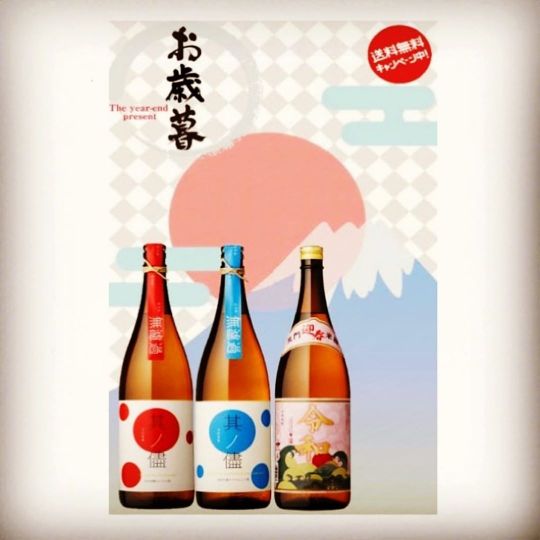
【令和1年お歳暮セット】 (日頃の感謝の気持ちを込めて) ( ※送料無料キャンペーン‼ ) 本日は、若潮酒造株式会社公式オンラインショップからのお知らせです。 若潮酒造公式オンラインショップにて、本数限定でお歳暮企画を開催しております\(^o^)/ 親愛なる人へのプレゼント、お返し、御歳暮、いつも頑張っている自分へのご褒美にいかがでしょうか? 令和1年お歳暮セットA 令和元年”の無濾過の新焼酎”其ノ儘(ソノママ)”と令和ラベルの3本セット 販売価格 = 6,982円(税込) 其ノ儘1.8ℓ(河内黒麹ゴールド)赤ラベル 令和初の無濾過"新焼酎"です。 濃厚で力強い味わい、スパイシーで大地の香りを感じます。 1次仕込み:令和元年8月29日 2次仕込み:令和元年9月4日 蒸 溜 日:令和元年9月11日 度数25度 容量1.8L 其ノ儘1.8ℓ(河内S型白麹菌)青ラベル 令和初の無濾過”新焼酎”です。 凜とした香り、ふっくら広がる甘み優しい香ばしさが特徴です。 1次仕込み:令和元年8月28日 2次仕込み:令和元年9月3日 蒸 溜 日:令和元年9月10日 度数25度 容量1.8L 令和ラベル1.8ℓ(干支ラベル) 毎年この時期だけ限定で販売している、年末年始にぴったりの特別ラベルです。 今年は、当蔵の代表銘柄でもある”さつま黒若潮”の特別バージョンとなっています。 ____________________________ 令和1年お歳暮セットB (送料無料) 販売価格 = 6,982円(税込) 其ノ儘1.8ℓ(河内黒麹ゴールド)赤ラベル 其ノ儘1.8ℓ(河内S型白麹菌)青ラベル さつま白若潮金箔入り1.8ℓ お正月にもピッタリの豪華な金箔入りの焼酎です。 送料無料です⁉️ 皆さん是非この機会にお買い求めください♪ ✨若潮酒造公式サイト✨ http://wakashio.shop-pro.jp/ ※会員登録お願い致します(๑•̀ㅁ•́ฅ✧ ____________________________ ✨若潮酒造受賞歴✨ 鹿児島県本格焼酎鑑評会 ✨21年連続受賞‼✨ ____________________________ ※若潮酒造の焼酎は、プリン体0・糖質0・甘味料0 、体に優しい芋焼酎です(^^♪ (焼酎飲み方案内) 冷やしてストレート、グラスにいっぱいに氷を入れてロック、グラスにいっぱいに氷を入れて炭酸水を入れてソーダ割り、グラスにお湯を入れてお湯割り、色々な飲み方をして楽しんで下さいね~♪ 日本全土 、 全都道府県 に若潮酒造の焼酎が広がるように頑張ります。 ( 北海道 青森県 岩手県 宮城県 秋田県 山形県 福島県 新潟県 茨城県 群馬県 栃木県 埼玉県 東京都 千葉県 神奈川県 山梨県 長野県 富山県 石川県 福井県 静岡県 愛知県 岐阜県 三重県 大阪府 京都府 滋賀県 兵庫県 奈良県 和歌山県 鳥取県 島根県 岡山県 広島県 山口県 徳島県 香川県 愛媛県 高知県 福岡県 佐賀県 長崎県 熊本県 大分県 宮崎県 鹿児島県 沖縄県 ) ★若潮酒造は見学、ツアーも出来ますので皆さん是非若潮酒造に遊びに来て下さいね♪ ( 会社が休みの場合も有りますので、見学に来られる際は事前に御連絡して下さいね。) 若潮酒造株式会社への 商品、見学、ツアー お問い合わせ 若潮酒造電話番号 = 099-472-1185 若潮酒造住所 = 鹿児島県志布志市志布志町安楽215 お気軽にお電話下さい (^^♪ ★☆★☆★☆★☆★☆★☆★☆★☆★☆★☆★☆★☆★☆★☆ ✨限定焼酎販売中✨ ※限定焼酎も販売しています\(^^)/ ✨若潮酒造株式会社 公式オンラインネットショップ✨ ★☆★✨ http://wakashio.shop-pro.jp/ ✨★☆★ ※登録方法が解らない方はこちら ↓↓↓↓↓↓↓↓↓↓↓↓↓↓↓↓↓↓↓↓↓↓↓↓↓↓ ★☆★☆★☆★☆★☆★☆★☆★☆★☆★☆★☆★☆★☆★☆ ✨登録方法✨ 若潮酒造公式オンラインショップ 登録のいろは = https://wakashioshopiroha.wixsite.com/wakashio-shop-iroha ✨会員登録の方法パソコンから✨ = https://wakashioshopiroha.wixsite.com/wakashio-shop-iroha/newmember ✨会員登録の方法スマートフォンから✨ = https://wakashioshopiroha.wixsite.com/wakashio-shop-iroha/blank-10 ★☆★☆★☆★☆★☆★☆★☆★☆★☆★☆★☆★☆★☆★☆ #若潮酒造 #若潮酒造株式会社 #其ノ儘 #其ノ儘黒麹 #其ノ儘白麹 #令和ラベル #さつま白若潮金箔入り #白若潮金箔入り #ソノママ #白若潮 #黒若潮 #御歳暮 #歳暮 #一年に一度 #感謝の気持ちを込めて #焼酎 #オンラインショップ #焼酎通販 #通販 #ネットショッピング #若潮酒造服部明 #本格焼酎 #芋焼酎 #麦焼酎 #お歳暮 #鹿児島県 #志布志市 #志布志 #しぶし ★☆★☆★☆★ (若潮酒造株式会社 オンラインショップ) https://www.instagram.com/p/B59TeWaAruo/?igshid=183tse35k6dzk
#若潮酒造#若潮酒造株式会社#其ノ儘#其ノ儘黒麹#其ノ儘白麹#令和ラベル#さつま白若潮金箔入り#白若潮金箔入り#ソノママ#白若潮#黒若潮#御歳暮#歳暮#一年に一度#感謝の気持ちを込めて#焼酎#オンラインショップ#焼酎通販#通販#ネットショッピング#若潮酒造服部明#本格焼酎#芋焼酎#麦焼酎#お歳暮#鹿児島県#志布志市#志布志#しぶし
0 notes
Photo

[ 漁光島藝術節 - 草木 花ノ市 ]市集吃起來 Part 3 這次的「 草木 花ノ市 」跟 「 漁光島藝術節 」時間長達一個月, 但是市集卻不會讓人覺得一成不變, 因為除了固定的幾個商家, 他們每個禮拜都會有不同的商家進駐, 即使是一樣的商家, 位置也會移動, 就像是在樹林裡面跟民眾們玩躲貓貓一樣, 甚至還有隱藏版在當週才會一天一天揭曉, 真的覺得很過分, 這樣根本逼人家每個禮拜去, 還好我定性夠, 只去了兩次的假日市集! 然後這天的市集體驗非常好, 相較於上次的不愉快, 遇到友善的店家, 良好的互動, 真的會讓食物的美味程度更加分, 只能說真的是開心的結尾。 加上巧遇大學同學來台南玩, 於是小小的導覽了一下, 真的是可遇而不可求的一次! [ H&H他她 ]- 市集限定雙堡組 最後一週的草木 森花ノ市, 他她也來了, 自從上次在森山市集吃了他們的香腸堡跟店裡的吐司之後, 就覺得一定要來吃, 而這次他們也推出了隱藏版的餐點, 這次他們推出了雙口味的餐包組合, 口味分別是 吻仔魚菠菜烘蛋跟梅香涼拌雞絲, 而且他們建議我們儘快食用, 至於原因後面會提到。 梅香涼拌雞絲吃起來是偏向比較清爽的口味, 可以吃得到微微酸甜的梅子醬, 搭配上水煮雞胸的肉絲, 吃起來很開胃; 而吻仔魚菠菜烘蛋在一入口時, 就可以感受到一股特別的海鮮味直衝嘴裡, 伴隨著淡淡的蛋香氣, 還有蛋的厚度也讓口感更好, 餐包部分則是鬆軟不油膩的口感, 但是梅香口味因為水分較多, 拿到後不快吃的話題 麵包部分會因為吸收了水分, 而變得糊糊的讓口感變得不好! 然後還點了杯香檸美式, 微酸的檸檬搭配上微苦的咖啡, 平衡得很好欸, 剛好可以解解吃了吻仔魚漢堡後, 嘴裡的魚味, 我可以再來一杯! [ 日和布丁 理想布丁提案 ]- 玉米濃布丁 其實市集第一天時, 就想吃他們家了, 但是因為一直找不到, 加上那天也吃不少家, 所以就放棄了, 但今天終於讓我吃到了! 選了一個特別的玉米濃布丁的極選限量口味, 當下看到這口味實在覺得疑惑, 想說是鹹的口味嗎? 會不會像蒸蛋一樣啊, 於是我又開口問老闆了(很愛找老闆麻煩的客人就是我), 老闆說他們這是用法式的手法下去製作, 就像法式濃湯會將裡面的材料用均質機將東西全部打碎, 所以會看不到裡面的材料本人。 他這款吃起來的味道沒有很明顯的蛋香, 感覺是牛奶或是鮮奶油的比例比較重, 但是吃起來不會有油膩感或是過重的奶香, 卻有一股淡淡特別但我說不上來的味道, 也因此他的質地會比較軟嫩, 不像雞蛋比重偏重的布丁, 吃起來會比較綿密, 口感也比較明顯。 搭配上微微苦甜的焦糖漿, 是吃起來舒服的布丁。 後來我又回到他們的臉書去找相關資訊, 赫然發現他們真的把玉米加到蛋液裡面, 所以真的嚇到我了, 但一點都不違和, 如果不說真的不會發現, 只會覺得說是一個好吃的布丁! [ 呦呼!炸麻糬 x 青空攝影 ] - 麵茶×紅豆 這家也是我第一天沒吃的漏網之魚, 有看到, 但吃不下了, 所以這次也是得吃才行! 最近有點麵茶控, 看到有麵茶的口味都會想點來試試看, 喜歡麵茶那股特別的香氣, 雖然只是把麵粉用乾鍋去炒過, 不過出來的香氣對我來說很迷人。 紅豆口味, 紅豆的味道不甜膩, 質感也是細緻的, 如果說他的麻糬是抹茶口味的話, 我應該會尖叫, 哈哈哈! #tainan #漁光島 #安棲之嶼 #台南 #漁光島藝術節2021 #草木森花之市 #yuguangartfest #他她咖啡 #anchovyandspinachtortillaburger #chickenbreastvelvetburgerwithplumsauce #呦齁炸麻糬 #dessertaholic (在 2021漁光島藝術節) https://www.instagram.com/p/CN6M9RFMvop/?igshid=139d7uafmdb0d
#tainan#漁光島#安棲之嶼#台南#漁光島藝術節2021#草木森花之市#yuguangartfest#他她咖啡#anchovyandspinachtortillaburger#chickenbreastvelvetburgerwithplumsauce#呦齁炸麻糬#dessertaholic
0 notes
Photo

二年生 花教室 サイゴノツドヒ お手モチヒサナ君たちニ ムツカシイカナア…其レハ杞憂of杞憂s 春告ゲノ黄色ヲ イトモかろやかニブウケニ紡イデユク君たち 君たち其々ノ肩ニハ春ノ妖精えふぇめらガ ホホヱンデ 僕ニハ見エタ こころガいっぱいニナッテ涙ガデサウダツタ 今日ノ君たちの手ガ編ンダその花束ハ其儘君たちノ美クシイぽるとれ たまゆらニ朽チユク花たちコソガ今ヲ忘レ得ヌ一瞬ニ象嵌スル ミンナ元気デネ マタ逢ヘタラ #双蕣庵 #花士 #双蕣庵花塾 #花業請負 #花教室 #出張教室 #flowerstagram #花のある生活 #花のある暮らし #茶花 #アレンジメントフラワー #flowerphotography #ブーケレッスン https://www.instagram.com/p/CLtzw2fFwty/?igshid=1nt94m7u9ouyx
0 notes
Text
43. 天狐ノ宿社
(英題)Mythology of the Sacred Fox
(簡体中題)天狐之宿社

2020/05/15
作曲: thus(2020)
編曲: thus(2020)
歌詞: thus(2020)
簡体中訳: LBN(2020)(thus監修)
絵: thus(2020)
動画: thus(2020)
(フォント: 梅明朝)
© 2020 thus. Composed by thus
ニコニコ動画
https://nico.ms/sm37167798
YouTube
https://youtu.be/jS5RJ4HEhQA
哔哩哔哩
https://www.bilibili.com/video/BV1H5411e7rV
---
巷(ちまた)に聞(き)く 妖(あやかし)は
その地力(じりき)を恣(ほしいまま)に
深(ふか)き憂(うれ)い 慰(なぐさ)めるとか
只(ただ)一度(ひとたび)目(め)にすれば
安寧(あんねい)なる業(ごう)を滾(たぎ)らせ
食寝処(くうねるところ)と住処(すみか)拠(よ)るとも
琳(リン)聯(レン)癪(シャク)廠(ショウ)游(ユウ)稗(ハイ)冽(レツ)合(ゴウ)
仂(ドウ)妍(ケン)笙(ショウ)櫂(カイ)吠(ハイ)妍(ケン)侗(ドウ)鍬(ショウ)
緬々(メンメン)崔(サイ)萱(ケン)金剛錫杖(コンゴウシャクジョウ)
壱(イッ)成(セイ)伂(ハイ)聶(ジョウ)卯(ミョウ)丞(ジョウ)白(ビャク)丼(ショウ)丯(カイ)
私(わたし)に見(み)た 人方(ひとかた)は
罪(つみ)儚(はかな)き 霊媒(れいばい)して
戦(おのの)きもせず 立(た)ち竦(すく)んでは
此(こ)の姿(すがた)に 畏敬(いけい)祟(たた)らせ
今(いま)独(ひと)りの其(そ)の身(み)折(お)らせ
おどろおどろしと手(て)合(あ)わせ詠(うた)う
「上肢帯(ジョウシタイ)ノ面上(メンジョウ)ニ 歯形(ハガタ)ガ其(ソ)ノ儘(ママ)残(ノコ)タ」
「妖臍帯(ヨウサイタイ)ヲ振(フ)テ 徹尾(テツビ)ヘ繋(ツナ)ガル 術(スベ)ニ傅(カシズ)ク」
「湾肢体(ワンシタイ)ノ静寂(セイジャク)ニ 遺誡(イカイ)ヲ受(ウ)ケ取(ト)リ嘆(ナゲ)クカ」
「然(サ)モ為(セ)ント思(オモ)ワバ 汝(ウヌ)ガ為(タメ)跪(ヒザマズ)カン」
人間方(じんかんほう)、己(おの)が心(こころ)読(よ)み熾(おこ)して
相対至高的(そうたいしこうてき)な 盤上芸美(ばんじょうげいび)を 無下(むげ)に讃(たた)える
人間方(じんかんほう)、私(わたし)の心(こころ)解(と)き放(はな)って
酌量(しゃくりょう)掛(か)けよ 不可量(はかるべからず)常世(とこよ)の鏡(かがみ)とも
天狗(てんぐ)が成(な)す 契約(けいやく)とは
羽(はね)を擱(お)いて 快(こころよ)くも
漸次(ぜんじ)の軛(くびき)を 打(う)ち建(た)てた
私(わたし)の見(み)た 人方(ひとかた)は
彼(か)の不思議(ふしぎ)な霊障(れいしょう)をして
生活圏(せいかつけん)に奉仕(ほうし)し給(たま)うた
巷(ちまた)に聞(き)く 妖(あやかし)は
その地力(じりき)を忌々(いまいま)しげに
物憂(ものう)げな覇気(はき)で抑(おさ)え込(こ)んでは
藁(わら)人形(にんぎょう)吊(つ)るし上(あ)げた
常日頃(つねひごろ)呪(のろ)いを掛(か)けた
『今日(きょう)とて人(ひと)の 労(ねぎら)い事(ごと)だ』
『上肢帯(ジョウシタイ)ノ面上(メンジョウ)ニ 歯形(ハガタ)ガ其(ソ)ノ儘(ママ)残(ノコ)タ』
『妖臍帯(ヨウサイタイ)ヲ振(フ)テ 徹尾(テツビ)ヘ繋(ツナ)ガル 術(スベ)ニ傅(カシズ)ク』
『湾肢体(ワンシタイ)ノ静寂(セイジャク)ニ 遺誡(イカイ)ヲ受(ウ)ケ取(ト)リ嘆(ナゲ)クカ』
『然(サ)モ為(セ)ント思(オモ)ワバ 汝(ウヌ)ガ為(タメ)跪(ヒザマズ)カン』
妖仙公(ようせんこう)、僕(ぼく)の容体(ようだい)御召(おめ)し給(たま)え
神仏先代(しんぶつせんだい)の無礼(ぶれい)の贖罪(しょくざい)を 今(いま)果(は)たさんと
妖仙公(ようせんこう)、君(きみ)が憂(うれ)い 受(う)け給(たま)えん
錫杖(しゃくじょう)を掛(か)けよ 不可触(ふれるべからず)常(とこ)の世(よ)の習(なら)わしで
琳(リン)聯(レン)癪(シャク)廠(ショウ)游(ユウ)稗(ハイ)冽(レツ)合(ゴウ)
仂(ドウ)妍(ケン)笙(ショウ)櫂(カイ)吠(ハイ)妍(ケン)侗(ドウ)鍬(ショウ)
緬々(メンメン)崔(サイ)萱(ケン)金剛錫杖(コンゴウシャクジョウ)
壱(イッ)成(セイ)伂(ハイ)聶(ジョウ)卯(ミョウ)丞(ジョウ)白(ビャク)丼(ショウ)
琳(リン)聯(レン)癪(シャク)廠(ショウ)游(ユウ)稗(ハイ)冽(レツ)合(ゴウ)
仂(ドウ)妍(ケン)笙(ショウ)櫂(カイ)吠(ハイ)妍(ケン)侗(ドウ)鍬(ショウ)
緬々(メンメン)崔(サイ)萱(ケン)金剛錫杖(コンゴウシャクジョウ)
壱(イッ)成(セイ)伂(ハイ)聶(ジョウ)卯(ミョウ)丞(ジョウ)白(ビャク)丼(ショウ)丯(カイ)
非望(ひぼう)なる神格化(しんかくか)から 見(み)えない人型(じんけい)願(ねが)った
心(こころ)を透(す)かし得(う)る 彼(か)の妖狐(ようこ)は 象牙(ぞうげ)を包(つつ)む
存在(そんざい)を逸(いっ)せれば 人(ひと)は幽体(ゆうたい)を乞(こ)うか
魂(たましい)を昇華(しょうか)せんと 汝(うぬ)が為(ため)跪(ひざまず)かん
上肢帯(じょうしたい)の内城(ないじょう)に 私(わたし)の歯形(はがた)を残(のこ)して
切(き)り裂(さ)く脈拍(みゃくはく)と 白血球(はっけっきゅう)迄(まで)飲(の)まし捧(ささ)げて
「当(トウ)痴態(チタイ)ノ破衣克(ハイカツ)ヲ 御召(オメ)シニナッテ下(クダ)サイ」と
言(げん)を奉(ささ)げよ 不可望(のぞむべからず)常(とこ)の世(よ)を離(はな)れて
妖仙公(ようせんこう) 君(きみ)が運命(うんめい)解(と)き放(はな)て
存在(そんざい)の成立(せいりつ)を 見(まみ)ゆるのならば 褒美(ほうび)に易(やす)し
人間公(じんかんこう) 汝(なんじ)、義恩(ぎおん)が哀温(あいおん)の
心(こころ)なるを寄越(よこ)す程(ほど)迄(まで) 犠牲(ぎせい)厭(いと)わぬとは
(上肢帯(ジョウシタイ)ノ面上(メンジョウ)ニ 歯形(ハガタ)ガ其(ソ)ノ儘(ママ)残(ノコ)タ)
(妖臍帯(ヨウサイタイ)ヲ振(フ)テ 徹尾(テツビ)ヘ繋(ツナ)ガル 術(スベ)ニ傅(カシズ)ク)
(湾肢体(ワンシタイ)ノ静寂(セイジャク)ニ 遺誡(イカイ)ヲ受(ウ)ケ取(ト)リ嘆(ナゲ)クカ)
(然(サ)モ為(セ)ント思(オモ)ワバ 汝(ウヌ)ガ為(タメ)跪(ヒザマズ)カン)
1 note
·
View note
Photo

✨新店情報 焼肉鍋たむら 天満総本店✨ ・ ・ ・ @yakinabeniku_tamura_honten ・ ・ ・ 最後にお得情報あり☆ ・ ・ ・ 今日は思いの外寒い風が吹いて、油断してお出掛けしてしまった私は寒い寒いと呪文の様に言っていました^^; ・ ・ ・ 皆様、お元気ですかー!笑 ・ ・ ・ 世間は三連休のなか日だったんですよね、どんな連休をお過ごしでしょうか? ・ ・ ・ 私は息子②とデートでした☆ ちょこっとストーリーにupしていまーす笑 ・ ・ ・ さてさて、新店情報が続きますが… ・ ・ ・ 明日、天満に2020年2月24日19時にOpenするのは ・ ・ ・ 関西人なら誰もが知っているハズ… 芸人の「たむけん」がプロデュースする『焼鍋肉』のお店☆ ・ ・ ・ んー・・・焼肉に鍋?? ・ ・ ・ とプレオープンにお呼ばれしまして、運ばれてきたお鍋を見ると ・ ・ ・ お〜!なるほどー!焼鍋肉ねーっ!! ・ ・ ・ まずは柔らかい塩タンを上のプレートで焼き、と同時に鍋も加熱され、「たむほる」と呼ばれる『たむけんのホルモン鍋』がグツグツと煮込まれて… ・ ・ ・ 上の鉄板から脂が下の鍋に滴り落ちて…ぐーんと旨味up! ・ ・ ・ 途中、鍋に入っていたホルモンを上の鉄板で焼き、香ばしく焼き目が付いた所で鍋に戻すと、これはー! ・ ・ ・ たまらーーーんっ☆ ・ ・ ・ ホンモン好きなら食べて欲しいと思う焼鍋肉でした(o´∀`o) ・ ・ ・ そしてそして〆の「ポックンパ」と呼ばれる〆ご飯。 ・ ・ ・ 我儘を言って申し訳け無かったのですが、外してあった鉄板を再度装着加熱!鉄板にポックンパを乗せて焦げ目を付けて頂くと ・ ・ ・ これまたたまらん〜〜っ☆ と2度目のたまらんが飛び出しました(* ॑꒳ ॑* ) ・ ・ ・ たむけんからのメッセージに、「ハッピーになりに来てください」とありましたが、うん!これはハッピーになれるっ☆ ・ ・ ・ 店内はシックな内装で、色んな所に獅子舞が 笑 ・ ・ ・ これはあれですよね、「ちゃ〜!」ですよねーっ 笑 ・ ・ ・ 明日はたむらけんじさんご本人も19時にオープン挨拶をなさる様です。 ・ ・ ・ そして最後にお得情報です! ・ ・ ・ なんと、お店にご来店された皆様に、オーナーたむらけんじから、太っ腹プレゼント! ・ ・ □『其ノ壱』たむらのホルモン鍋 通販の伝説の商品「たむらのホルモン鍋(2980円相当)」総レビュー4.93の不動の人気商品なんだそうですよ! □『其の弐』たむらのブラックカード! 大阪総本店のみで使える生ビール、ハイボール何杯でも永久100円のたむらのブラックカードをプレゼント! 来店し並んだお客様へ先着配布枚数300枚2月24日のみの配布限定 ・ ・ ・ さすがたむけん太っ腹〜! ・ ・ ・ 連休最終の〆に良いかもですね(๑•̀ •́)و✧ ・ ・ ・ ごちそうさまでした ・ ・ ・ #天満 #天六 #天満グルメ #天六グルメ #天五商店街 #焼鍋肉 #焼鍋肉たむら天満総本店 #焼鍋肉たむら #どるふぃんの気ままに食べ歩き #たむけん #たむらけんじ #プロデュース #たむほる #グランドオープン #新店情報 #新店 (Temma, Kita-ku) https://www.instagram.com/p/B86TPItAf92/?igshid=g6aiutgl75cl
#天満#天六#天満グルメ#天六グルメ#天五商店街#焼鍋肉#焼鍋肉たむら天満総本店#焼鍋肉たむら#どるふぃんの気ままに食べ歩き#たむけん#たむらけんじ#プロデュース#たむほる#グランドオープン#新店情報#新店
0 notes
Text
河井弥八「西園寺公望談話筆記」(1926年11月15日)
西園寺公望談話筆記(大正15年11月15日)
叙久闊、構ハズ訪問スベシ。予〔西園寺公望〕ハ未知ノ紹介ナキ人ニハ絶対ニ会ハズ。来訪者中ニハ面会セヌ方、宜シト云ハルル人モアレド、其心持ニテ会ヘバ足レリ。凡テ各人各様ノ立場ヨリ希望ヲ持来ルモノナリ。
此頃ハ種々ノ問題連続シテ発生スト雖、朴烈問題ノ如キハ左程重大トハ思ハズ。先年、呂運亨問題ガ議会ニ喧囂タリシニ比シ、稍重キガ如シ。当時原〔敬〕首相ハ此小問題ニ付テ、尚議会ニアヤマリ恐悚ノ文字マデ用ヰシコトアリ。
此頃ノ憂国者ニハ余程偽物多シ。大問題ニモアラヌモノヲ捉ヘテ妄リニ皇室ノ尊厳ヲ語リ、皇室ヲカサニ着テ政府ノ倒壊ヲ策スルモノスラアリ。而カモ彼等ハ時局ヲ収拾スルノ実力ヲ有セズ。決シテ彼等ニ誤ラルル勿レ。不純ノ動機ヲ包蔵スルモノ皆然リ。
国粋論者ハ動モスレバ狭キ見解ニ拘泥シテ他ヲ見ズ、固陋甚シク却テ有害ナリ。我国ノ文明ハ決シテ左様ノモノニ非ザルナリ。外国ノ思想文物ノ消化応用ノ跡ヲ見ルベシ。或ハ又、曩ニ極端ナル社会主義ヲ唱ヘシモノニシテ、今ハ翻テ皇室中心主義ヲ説ク者アリ。之ハ金銀両建ト同様ナリ。
箕浦〔勝人〕ノ提起シタル告訴事件ハ面白カラズ。若槻等ノ言葉ノ如何ハ知ラザルモ、之ガ解釈ニ付テ誤謬ヲ生ゼシモノナラン。元来政治家ノ清節ナルモノハ甚疑ハシ。予ノ政治ニ関係セシ時ノ事実ニ照シテ斯ク断言ス。故ニ本件ニ付テハ党派的画策ナキヤ、或ハ又司法官ノ倒閣運動ヲ加味セズヤ、司法部内ニハ閥ノ勢力アリ、大浦事件ノ顛末ヲ知ラズヤ。
斯ノ如ク奇怪ノ紛争続出シ逐次深刻ヲ加フルニ於テハ、爰ニ最憂慮スベキ事態ヲ生ズルノ虞ナシトセズ。摂政殿下ニ対シテ英断ヲ下サセ給フコトヲ仰グノ一時、是ナリ。若万一御一断ヲ下シ給ハバ、是レ実ニ殿下ヲ政争ノ渦中ニ入ラシメ奉ルコトナリ。怖ルベシ。
摂政殿下ハ親ラ政務ヲ御指揮アラセラルベカラズ。各種官職ニ在ル者ヲシテ、如何ニシテ其全知全能ヲ竭サシムベキカヲ御考案アラセラルベシ。殿下ハ又、努メテ臣下ノ人物材能ヲ御知悉アラセラルルヤウ願ヒタキモノナリ。
摂政殿下ニハ政務世事等ニ関シ広ク御通暁アラセラルルヤウ、各方面ヨリ啓沃シ奉ラザルベカラズ。国務大臣、内大臣、宮内大臣等の重要任務ナリ。政務ノ詳細ニ関シテハ、国務大臣ハ必シモ自ラ凡テヲ御説明申上グルニ及バズ。殿下ノ御許諾ヲ得テ局長等ヲシテ言上セシムルモ可ナリ。嘗テ御進講ヲ陪聴シタルコトアリ。今少シクカタクナラヌ様ニ致シタシト思ヘリ。殿下ヨリ自由ニ御質問ヲ発セラルルヤウ致シタキモノナリ。陪聴者モ質問ヲ発シ、御進講者ト相俟テ聡明ヲ裨輔シ奉ルベシ。
政局ハ此儘解散迄推進ムベシ。解散ニ依リテ万事解決スルノ外ナシ。但シ松島事件ガ意外ノ点マデ進展シ、議会召集前、政府倒壊ニ至ラバ、一大英断ヲ以テ政党ノ離合集散ヲ行フ者ノ出ヅルノ外ナカルベシ。政党ニ立脚セザル中間内閣、若ハ総選挙ノ為ノミニスル超��内閣組織ノ如キハ断然不可ナリ。後者ハ違憲ナリ。
摂政殿下大演習行啓ヲ御中止アラセラレタルハ甚宜シ。但シ此事ヲ御決定ノ前ニ内大臣、宮内大臣等ハ首相、陸相、内相等ト協議シタルノ事実アリヤ。元老多数在世ノ時ハ斯カル事ニ関シ、宮中府中ノ打合セハ常ニ完全ニ行ハレタリ。然ルニ近時両者ノ間、兎角疎遠トナリシガ如キ観アリ。是レ山県公ノ官僚思想ニ出デンガ如シ。
摂政殿下側近者ハ今少シク世ノ事情ニ通ジ、所謂垢抜ケシタルコトヲ希望ス。平生御昼食ノ際ニハ大夫初メ御同卓申上ゲ、又毎回相当ノ人物ヲ召サレ、談笑ノ間ニ御自ラ御知見ヲ広ウセラルルヤウ考案アリタシ。斯クセバ殿下ニハ、自然ニ人物鑑識ノ御才能ヲ涵養セラルルニ至ラン。有爵議員ナドヨリモ適当ノ人選アラン。自薦者ハ不可ナリ。
皇后陛下ニハ過日児玉〔秀雄〕関東庁長官ニ対シ、政務ニ関スル御沙汰アリシヤノ記事ヲ新聞紙上ニテ承知セリ。之ハ事実ニ非リシコト明瞭トナリ、大ニ安心シタリ。
天皇陛下御病気ニ付、皇后陛下御看護ノ厚キコト恐懼スル所ナリ。併ナガラ宮中ニハ古来ノ習慣ノ奇異ナルモノアリ。看護婦ノ御使用方、医師ノ注射ヲ交代ニテナスコト等、意外ノコト少カラズ。
供御
最近ノ如ク事端漸ク繁カラントスル時ニハ別シテ諸事ニ注意ヲ要ス。殊ニ陛下御病気ノ際、陰謀的行為ナドノ勃発スルコトアラバ一大事ナリ。
若槻内閣ハ政策ニ於テハ未失敗セリト云フベカラズ。
*高橋紘ほか編『昭和初期の天皇と宮中 侍従次長河井弥八日記』第6巻(岩波書店、1994年) 233ー234頁
0 notes
Video
instagram
※限定焼酎発売中♪ 【限定焼酎 其ノ儘 (そのまま)編 動画】 ( 11月1日 威風堂々登場 ) 皆様、お待たせいたしました\(^o^)/ 11月1日より 限定焼酎 其ノ儘 (そのまま) 販売開始致しました♪ 限定焼酎 其ノ儘 (そのまま) 情報 ① 其ノ儘(白麹) そのまま 販売価格 2,543円(税込) 令和初の無濾過”新焼酎”です。 凜とした香り、ふっくら広がる甘み優しい香ばしさが特徴です。 ② 其ノ儘(黒麹) そのまま 販売価格 2,543円(税込) 令和初の無濾過"新焼酎"です。 濃厚で力強い味わい、スパイシーで大地の香りを感じます。 限定焼酎 其ノ儘 (そのまま) 凄く美味しい焼酎なので是非飲んでみて下さいね♪ ※人気商品の為売り切れになる場合も有りますが、ご了承くださいませ。 其ノ儘の動画造りました♪ 詳しい情報は、下の動画を見て下さいね~♪ ※動画は、服部明個人の製作による個人動画です。若潮酒造株式会社は一切関係ありません。 限定焼酎 其ノ儘 (そのまま) 動画 youtube ユーチューブ = https://youtu.be/I3dcaR6FxAM ✨若潮酒造公式サイト✨ http://wakashio.shop-pro.jp/ ※会員登録お願い致します(๑•̀ㅁ•́ฅ✧ ____________________________ ✨若潮酒造受賞歴✨ 鹿児島県本格焼酎鑑評会 ✨21年連続受賞‼✨ ____________________________ ※若潮酒造の焼酎は、プリン体0・糖質0・甘味料0 、体に優しい芋焼酎です(^^♪ (焼酎飲み方案内) 冷やしてストレート、グラスにいっぱいに氷を入れてロック、グラスにいっぱいに氷を入れて炭酸水を入れてソーダ割り、グラスにお湯を入れてお湯割り、色々な飲み方をして楽しんで下さいね~♪ 日本全土 、 全都道府県 に若潮酒造の焼酎が広がるように頑張ります。 ( 北海道 青森県 岩手県 宮城県 秋田県 山形県 福島県 新潟県 茨城県 群馬県 栃木県 埼玉県 東京都 千葉県 神奈川県 山梨県 長野県 富山県 石川県 福井県 静岡県 愛知県 岐阜県 三重県 大阪府 京都府 滋賀県 兵庫県 奈良県 和歌山県 鳥取県 島根県 岡山県 広島県 山口県 徳島県 香川県 愛媛県 高知県 福岡県 佐賀県 長崎県 熊本県 大分県 宮崎県 鹿児島県 沖縄県 ) ★若潮酒造は見学、ツアーも出来ますので皆さん是非若潮酒造に遊びに来て下さいね♪ ( 会社が休みの場合も有りますので、見学に来られる際は事前に御連絡して下さいね。) 若潮酒造株式会社への 商品、見学、ツアー お問い合わせ 若潮酒造電話番号 = 099-472-1185 若潮酒造住所 = 鹿児島県志布志市志布志町安楽215 お気軽にお電話下さい (^^♪ ★☆★☆★☆★☆★☆★☆★☆★☆★☆★☆★☆★☆★☆★☆ ✨限定焼酎販売中✨ ※限定焼酎も販売しています\(^^)/ ✨若潮酒造株式会社 公式オンラインネットショップ✨ ★☆★✨ http://wakashio.shop-pro.jp/ ✨★☆★ ※登録方法が解らない方はこちら ↓↓↓↓↓↓↓↓↓↓↓↓↓↓↓↓↓↓↓↓↓↓↓↓↓↓ ★☆★☆★☆★☆★☆★☆★☆★☆★☆★☆★☆★☆★☆★☆ ✨登録方法✨ 若潮酒造公式オンラインショップ 登録のいろは = https://wakashioshopiroha.wixsite.com/wakashio-shop-iroha ✨会員登録の方法パソコンから✨ = https://wakashioshopiroha.wixsite.com/wakashio-shop-iroha/newmember ✨会員登録の方法スマートフォンから✨ = https://wakashioshopiroha.wixsite.com/wakashio-shop-iroha/blank-10 ★☆★☆★☆★☆★☆★☆★☆★☆★☆★☆★☆★☆★☆★☆ #限定焼酎其ノ儘 #そのまま #限定焼酎 #焼酎 #其ノ儘 #其の儘 #焼酎お湯割り #志燦蔵 #若潮酒造株式会社 #若潮酒造 #蔵元直売所 #鹿児島県 #志布志市 #志布志町 #志布志 #しぶし #志布志市志布志町志布志 #本格焼酎 #芋焼酎 #ショウチュウ #国酒 #ユーチューブ #若潮酒造株式会社公式オンラインショップ #若潮酒造オンラインショップ #水割り #炭酸割り #無濾過 #ロック #youtube #若潮焼酎 ★☆★☆★☆★☆★☆★☆★☆★☆★☆★☆★☆★☆★☆★☆ 若潮酒造服部明。 私の個人サイトなので、お気軽にフォローして下さいね。 Instagram インスタグラム = https://www.instagram.com/wakashio_hattori/ Twitter ツイッタ― = https://twitter.com/wakashio11 youtube ユーチューブ = https://www.youtube.com/channel/UC9iyw41rfoD-_jOSQiDQx1g アメーバブログ = ht (若潮酒造株式会社) https://www.instagram.com/p/B44p9OCA5Ii/?igshid=1soxwjhcc03xr
#限定焼酎其ノ儘#そのまま#限定焼酎#焼酎#其ノ儘#其の儘#焼酎お湯割り#志燦蔵#若潮酒造株式会社#若潮酒造#蔵元直売所#鹿児島県#志布志市#志布志町#志布志#しぶし#志布志市志布志町志布志#本格焼酎#芋焼酎#ショウチュウ#国酒#ユーチューブ#若潮酒造株式会社公式オンラインショップ#若潮酒造オンラインショップ#水割り#炭酸割り#無濾過#ロック#youtube#若潮焼酎
0 notes
Text
Nampō Roku, Book 2 (2): (1586) Tenth Month, First Day, Go-atomi [御跡見].

2) The same day¹.
Things were left [exactly] as they were [when Hideyoshi departed]².
◦ [Guests³:] Bizen-saishō [備前宰相]⁴, Sōmu [宗無]⁵, Sōkei [宗惠]⁶.
◦ The room was the same⁷.
﹆ Toko: the flower arrangement [by Toyotomi Hideyoshi] was left as it was⁸.
◦ On the shelf, the remainder of the tea, [in] the Shiri-bukura, on its tray⁹.
﹆ When [the guests] entered the room, everything remained as it had been¹⁰; the kama was lifted up so that [the new guests] could have a look at the remains of the charcoal [that had been arranged by Hideyoshi]¹¹.
◦ And again, a little more [charcoal] was added, and the kama returned [to the ro]¹².
▵ Kashi ・ senbei [センヘイ], kobu aburite [コフ アブリテ]¹³.
Go [後]¹⁴.
Kurete [暮テ]¹⁵.
◦ Toko: after [Hideyoshi's] flower [arrangement] was taken away¹⁶, a tōdai [燈臺]¹⁷ [was hung up in its place].
﹆ The Shiri-bukura was lowered [to the mat]¹⁸.
◦ Mizusashi: the same as before¹⁹.
◦ On the shelf: the habōki²⁰.
◦ Chawan: as before²¹.
Everything else was the same [as earlier in the day]²².
_________________________
¹Onaji hi [同日].
This means “the same day.”
It was the first day of the Tenth Lunar Month of Tenshō 14 [天正十四年] (1586).
²Go-ato ni sono-mama [御跡ニ其儘].
Go-ato [御跡]: go [御] is an honorific (it indicates that someone important did something*); ato [跡] literally means footprints. In other words, everything was left exactly as it was when Hideyoshi left the room†.
Sono-mama [其儘] means "as it is;" "as one finds it;" "as (things) stand."
__________
*In this case, it was what remained (in the room) after Hideyoshi took his leave.
†In this kind of construction, ato refers to the (intact) setting (just recently) vacated by an important personage -- i.e., Hideyoshi.
³In this kaiki, the names of the guests are simply listed without being introduced by the word “guests.”
⁴Bizen-saishō [備前宰相].
This refers to the daimyō and nobleman Ukita Hideie [宇喜多秀家; 1572 ~ 1655], who, in addition to being the lord of Bizen [備前] and Mimasaka [美作] provinces*, served as an Imperial Chamberlain (jijū [侍従]), Imperial Councillor (sangi [参議]), lieutenant-general of the Left Imperial Guards (sa-konoe ken-chūjō [左近衛権中将]), and provisional Vice-councilor of State (gon-chūnagon [権中納言]), ultimately attaining the second grade of the Third Rank (ju-sanmi [従三位]†.
Hideie also was a member of Hideyoshi’s Council of Five Elders (go-tairō [五大老]), which was created to act as the regent for Toyotomi Hideyori after his father’s death, and opposed Tokugawa Ieyasu at the battle of Sekigahara, for which he was exiled to Hachijō-jima [八丈島], an island in the Philippine Sea far distant from the Japanese archipelago.
The sobriquet Bizen-saishō [備前宰相], which means something like “Chancellor of Bizen,” was Ukita Hideie’s nickname, due to his huge influence over the affairs of this province.
___________
*Both provinces form part of modern-day Okayama Prefecture. The village of Imbe [伊部], which is in Bizen, is the original home of Bizen-yaki.
†Though at the time of this chakai, Hideie was of course not such a high noble. His father, Ukita Naoie [宇喜多直家; 1529 ~ 1581], the hereditary lord of Bizen, had died several years before, and Hideie was elevated to a prominent position several months later at the very young age of 10, by the Oriental way of counting. (At the time of this chakai, Hideie was just 15 years of age according to the same way of counting ones age where the person is assigned the age of “one” at birth.)
Hideie was subsequently adopted by Toyotomi Hideyoshi after he married Hideyoshi’s adopted daughter Gōhime [豪姫; 1574 ~ 1634 -- whose birth-father was the great lord Maeda Toshiie], and it may have been for some such reason that Hideyoshi invited him to attend this atomi (and possibly was the reason why Hideyoshi deigned to arrange the charcoal before serving usucha to his two attendants and Rikyū -- to impress the young man with the importance of mastering chanoyu as his soon-to-be-adoptive-father had done).
It might be doubted whether Hideie was actually known as Bizen-saishō at the time when this chakai took place (since he would have only just celebrated his gempuku [元服], or ceremony of attaining manhood, earlier in the year). The use of this sobriquet, then, might represent a later emendation (perhaps intended to clarify the identity of the guest, and so associate him with the person thus named in the Rikyū Hyakkai Ki).
⁵Sōmu [宗無].
This refers to Okayama Hisanaga [山岡 久永; 1534 ~ 1603*], who is also known as Sumiyoshi-ya Sōmu [住吉屋宗無]†. He was a wealthy townsman from Sakai, and also a highly respected chajin‡, and served as one of Hideyoshi’s Eight Masters of Tea (sadō hachi-nin-shū [茶頭八人衆]).
Sōmu’s presence as the ji-kyaku was very likely intentional (perhaps at Hideyoshi’s direction)**, so that he could assist Hideie (who, at his young age, probably did not know much about chanoyu††).
___________
*Certain accounts suggest that Sōmu may have died in 1595, at the time when Sakai was razed on Hideyoshi’s orders (as a punishment for the city-state’s opposition to his invasion of the continent).
†He is identified in this way in the other versions of the Hyakkai Ki.
‡Sōmu is said to have first studied chanoyu under Jōō, and then later with Rikyū (though, given his high standing with both Nobunaga and Hideyoshi, this latter assertion might be a revisionist opinion popularized by the Sen family during the Edo period).
He studied Zen under Shunoku Sōen oshō [春屋宗園和尚; ? ~ 1611], from whom he received the name Sōmu [宗無] -- which he used as his professional name later in life.
**In the Hyakkai Ki, Sōmu frequently appears in a role that might be interpreted as being Rikyū's assistant, in situations where the shōkyaku either was inexperienced, or his rank indicated that he needed to be treated with especial deference (in such a case, Sōmu would convey the chawan to him, for example, and then return it to the host after the shokayku had finished drinking).
††Since only usucha would have been served at this atomi, this may have been Hideie's first experience of chanoyu. Thus the atomi is being staged as a sort of miniature chakai.
⁶Sōkei [宗惠].
This refers to Mizuochi Sōkei [水落宗惠; dates of birth and death unknown], who was another respected machi-shū chajin from Sakai*. He is also said to have been the father of Rikyū's son-in-law, Sen no Jōji [千 紹二]†.
__________
*Some suggest that he was also one of Rikyū's disciples (though it is more likely that he was a member of the group that formed around Rikyū in the years after Jōō’s death -- given Sōkei’s contemporary reputation as a chajin).
†Sōkei's son is usually known as Sen no Jōji because Rikyū adopted him into the Sen family upon his marriage to Rikyū's daughter (Rikyū having only one biological son -- which, for a merchant, was akin to putting all of ones eggs in one basket).
⁷Onaji zashiki [同座敷].
Literally, the same sitting-room.

This refers to the 2-mat room which Rikyū used during the chakai for Hideyoshi (that had just concluded).
⁸Toko ・ go-hana sono-mama [床 ・ 御花其マヽ].
Go-hana [御花]: the use of the honorific (go [御]) means that Rikyū is referring specifically to the chabana created by Hideyoshi (which Rikyū moved from the floor of the toko to the hook attached to its rear wall). Hideyoshi's chabana (white chrysanthemums in an Arima-kago [有馬籠] -- this basket is shown below) was left as it was.

The Shigaraki hanaire and usu-ita would have been removed from the toko after Hideyoshi left.
⁹Tana ni go-cha no nokori, Shiri-bukura ・ bon ni [棚ニ御茶ノ殘、尻フクラ・盆ニ].
Go-cha no nokori [御茶の殘り]: the use of the honorific (go [御]) indicates that this was the matcha remaining from what had been used to serve Hideyoshi.

As was mentioned before, the Shiri-bukura [尻膨] was Rikyū’s most prized chaire; and it was from contemplating this bon-chaire that his unique ideas about how to perform the bon-date temae arose*.
Because reused tea could only be served as usucha, Rikyū is also suggesting that koicha was not served to Hideie and the others (as was sometimes done in other atomi no chakai).
___________
*This was perhaps the greatest difference between Rikyū’s chanoyu and that of Jōō (who created the bon-date temae). Oddly (considering the over-blown lip service that they accord to Rikyū), none of the modern schools perform bon-date in his way: all of them prefer to do this temae the way Jōō did it (even though most of the modern schools prefer to use the smaller “Rikyū-sized” chaire-bon, rather than the larger trays -- now almost always used as higashi-bon -- that were employed by Jōō and his disciples).
¹⁰Za-iri sono mama [座入其マヽ].
This means that when the guests entered the room for the (abbreviated) sho-za of this atomi no chakai, the ro was left exactly as it had been when Hideyoshi departed. This was important, since the idea was to allow the guests to inspect the charcoal laid* by Hideyoshi.
__________
*Actually, Hideyoshi had simply repaired the fire that had been laid by Rikyū. Nevertheless, the condition of the different pieces of charcoal would make this obvious to someone who understood chanoyu; while simply impressing the importance of mastering chanoyu to the young man who was nominally the shōkyaku at this atomi. (This atomi seems to be attended by mock formality, which in turn suggests that this may have been Hideie's first experience of chanoyu.)
¹¹Kama agete go-sumi no nagori ikken [釜アケテ御炭ノ名殘一覧].
Ageru [上げる] means to raise something up; lift something up; bring something up. The kama was lifted out of the ro (and presumably stood on a kamashiki that was placed on the left side of the utensil mat*). This allowed the guests to have an unobstructed view of the interior of the ro.
Go-sumi [御炭]: once again, the use of the honorific indicates that this refers to the charocoal arranged (or repaired) by Hideyoshi.
Nagori [名殘] means, remains, remnants, vestiges. Since the time of Jōō it had been said that the host's skill could be ascertained by the remains of his arrangement of the charcoal (since the vestiges of the fire showed not only the arrangement, but the manner in which the fire had taken hold, and burned down -- things that were just as important as the beauty of the arrangement itself).
Ikken [一覧] means to glance at something; to have a look at something.
___________
*I have seen a commentary that suggested that the kama was left suspended on a chain several shaku above the mouth of the ro, so that the guests could look at the fire underneath.
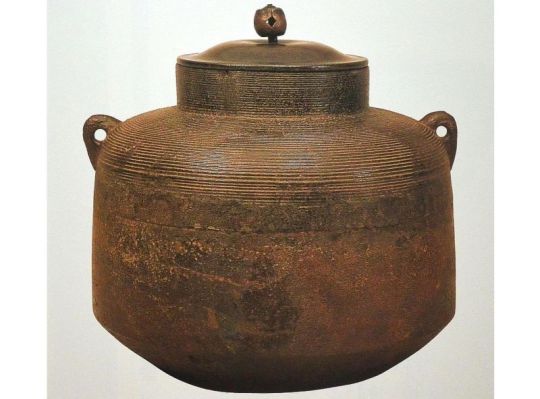
However, given the size and weight of Jōō‘s ito-me kama [絲目釜] (shown above), this would have been ill-advised (since it would look very dangerous to the guests, even if the chain and ceiling were actually strong enough to support it).
This interpretation was probably the result of the result of the commentator (who was not a practitioner of chanoyu) misunderstanding the word kakuru [掛くる] -- see the next footnote.
¹²Mata sukoshi oki-soe, kama kakuru [又少置添、釜カクル].
Oki-soeru [置き添える] means to place something beside (something else); add one thing to another. The new pieces of charcoal were placed next to the burning pieces, so that they would catch fire slowly (and so keep the kama boiling until the "gathering" was ended).
Kama kakuru [釜掛くる] literally means to hang or suspend the kama (over the ro). This expression originated in the old days, when the kama was suspended over the ro on a chain*. And it remained the way to express the idea of returning the kama to the ro even after the kama came to be placed on top of the gotoku.
This sentence is a good example of the way that Rikyū expressed himself. It is much closer to Korean syntax than Japanese (I was asked to point this kind of thing out by certain followers of this blog).
___________
*The expression is also used with regard to placing the kama on a furo. This may be an example of post hoc terminology; or the fact that the original furo was a kake-awase furo on which a kiri-kake kama was suspended -- here used because the kama rests on the ring-like mouth of the furo, with part of it hanging below the point of contact.
¹³Kashi ・ senbei, kobu aburite [菓子 ・ センヘイ、コフ アブリテ].
Senbei [煎餅] are rice crackers. They would have been procured from a specialty shop.
Kobu aburite [昆布 炙りて] means konbu (kelp) that has been toasted over a charcoal fire (rather than boiled in broth and tied into a bite-sized knot, which is the other way that it could be served as a kashi).

The kashi would have been served in a shallow vessel of some sort -- perhaps on a large dish, resting on an unpainted oshiki [折敷].
This kind of chakai, where only kashi are offered to the guests, is sometimes referred to as a kashi-kai [菓子會].
After eating their kashi, the guests would have gone out for a brief naka-dachi, while Rikyū readied the room for the service of tea.
¹⁴Go [後].
This indicates that what follows occurred during the go-za [後座], the second half of the chakai when tea is served.
¹⁵Kurete [暮テ].
Kureru [暮れる] means to become dark. The day is drawing to a close, and it is now dark enough outside that artificial illumination is needed within the room.
¹⁶Toko ・ go-hana tori-irete [床・御花取入テ].
Tori-irete [取り入れて] means to bring something in -- in this case, into the katte.
That is, the flowers arranged by Hideyoshi were removed from the tokonoma.
¹⁷Tōdai [燈臺].
This is a kake-tōdai. It is an L-shaped stand (sometimes made of wood and metal, and sometimes made from a piece of bamboo -- the two most common styles are shown in an Edo period sketch, below) that can be hung on the wall (in this case, from the hook attached to the back wall of the toko), which in turn supports a saucer of oil containing several burning wicks made of the pith of the lamp-rush plant (Juncus effusus var. decipens), called igusa [藺草] in Japanese.

Hanging the kake-tōdai in the toko (in place of the flower arrangement) is a practice called tō-ka [燈華] -- which is usually translated as “flower of the lamp” (though apparently without a clear understanding of what is intended, on the part of the translator).
This word is a pun (the homophonous tō-ka [燈火] is the “lamp-flame,” the source of the light); but hanging the tōdai in the toko, as a substitute for the chabana, was one of Jōō's most closely guarded secrets (and this is the reason why chabana were not displayed at night -- because the flame takes the place of the flowers).
¹⁸Shiri-bukura oroshite [尻フクラヲロシテ].
Orosu [下ろす]* means to lower something (in this case, from the shelf to the mat).
According to Rikyū's densho, precious utensils should not be placed on the shelf when it is dark (since the presence of candles on the floor will throw the things on the shelf into shadow, making it easier for the host to inadvertently knock them over when he goes to lower them to the mat).
Furthermore, the Shiri-bukura chaire now contains used tea (that will be served as usucha). Thus it is not appropriate for the tea container to be displayed on the shelf at the beginning of the service of tea.
The Shiri-bukura chaire, on its red Chinese tray, was placed on the mat, in front of the mizusashi.
___________
*Oroshite [下ろして] is, of course, past tense.
The Shiri-bukura chaire, on its tray, was lowered to the mat during the naka-dachi. It was already resting on the mat, in front of the mizusashi, when the guests entered the room for the go-za.
¹⁹Mizusashi ・ migi-dō [水指・右同].
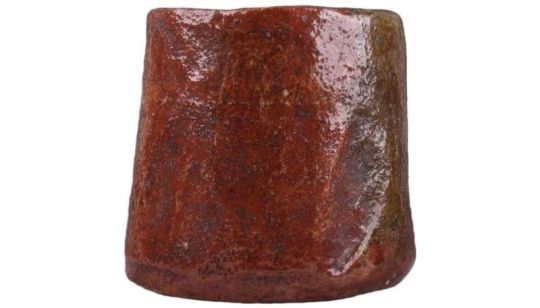
As before, this was the aka-Raku yahazu-kuchi mizusashi [赤樂矢筈口水指] that had been made for Rikyū by Chōjirō.
²⁰Tana ni habōki [棚ニ羽箒].
This would have been the same go-sun-hane, made from the feathers of the shima-fukurō [島梟].

In Rikyū's temae, the habōki was used to dust the utensil mat at the end of the service of tea, as well as after the sumi-temae*.
Furthermore, it is a rule that, if there is a tana preset in the room, it should never be empty when the guests enter the room, or when they leave.
At the end of the temae, the hishaku and futaoki would be placed on the tana; and after dusting the utensil mat, the go-sun-hane would be removed from the room.
__________
*Neither of these things are usually done in the modern school’s temae.
When the utensil mat is a maru-jō [丸疊] -- a full-length tatami -- the habōki is used to dust only the upper end of the utensil mat (which is equivalent in size to a daime).

After sliding out of the katte-guchi, the host turns around and leans back into the room, and cleans the lower 1-shaku 5-sun of the mat with a za-baki [座掃], a large feather broom (usually made from the pinions of a large bird, such as an eagle, such as shown above) that is used for cleaning the room in general.
²¹Chawan ・ migi-dō [茶碗・右同].

This was the Wari-kōdai [割り高臺] chawan, a very old Korean bowl that had been brought to Japan by one of the refugees escaping the Ming military invasion of Korea in the mid-fifteenth century.
²²Sono-hoka nanimo mina onaji [其外何モ皆同].
Everything else was the same (as during the earlier chakai).
This means that all of the other utensils* that have not been mentioned above were the same.
But it also means that things were done in the same way as earlier* -- in other words, the chawan (with chakin, chasen, and chashaku arranged in it) was placed inside a (new) mentsū [面桶]†, and so everything not already displayed in the room was brought out at one time.
___________
*In other words, the kōgō would have been his ruri-suzume [瑠璃雀].
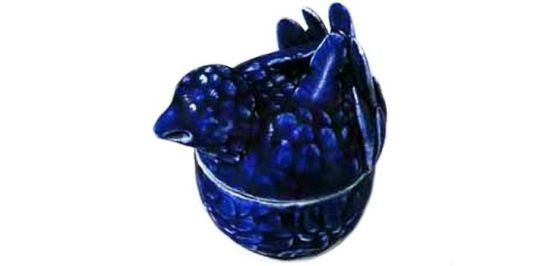
And Rikyū would have used an ori-tame [折撓] that he had made himself, as his chashaku.

While the futaoki would have been a take-wa [竹〇], as was almost always the case at Rikyū’s wabi chakai.

As earlier in the day, the hishaku would probably have been resting on the futaoki, on the left side of the mizusashi, with its handle parallel to the left heri of the mat.
†The only exception to which was that only usucha would be served during this atomi no chakai. Both because tea that had already been used to serve koicha at an earlier chakai could never be used to serve koicha at a subsequent gathering.
But also because, if this were Hideie’s first experience of chanoyu, he would probably not like koicha -- which is an acquired taste: the host must always consider the shōkyaku when deciding what he is going to do.
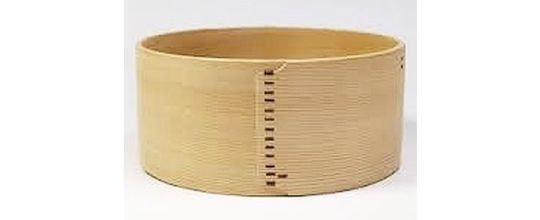
‡The mentsū [面桶] (above) should only be used one time, since absolute purity is its special feature. This is the reason why the chawan could be placed inside of the mentsū and so carried into the room -- something that would be unthinkable were the host using any other kind of koboshi (which could be used again and again).
2 notes
·
View notes
Photo










気違宗中本山
不動山前進寺
縁起絵巻
当山は山号を不動山と称し、寺号を前進寺と、称します
名は体を現す、と申しますが、
「不動なるが故に前進す、前進するが故に不動なり」と云う
御教えを体現しております、有り難い山号寺号であります
古来より流されやすい世相に、竿を指してまいりましたら、
いつしか、世の中の方が変わり過ぎ、動かざること山の如きに変わらなかったのが、ワルカッタのか、ソウなのか、だが、しかし、其の故に前進していると言いましょうか、はたまた、世の中が変わってしまって、変わらないのは当山だけなので、不動だ、と言いましょうか、いや、まったく、世の中の三千億万劫、遅れ���いる、と言いましょうか、はたまた、六千憶万��由旬後方に居てると言いましょうか、遅れついでに、古来より、きちがい寺と親しまれ、参詣の善男善女悪男悪女が絶えることなく、参詣されておりますところで御座います。
また、
「我もまた、狂者と為りて、この国を破滅させん、この社会に仇を為さん」
「少なくとも精神医と看護婦看護士と心理職には落とし前を付けなん」と
狂之修行者の入山も後を絶ちません
一般には、山科のきちがい寺、きーさん寺、日ノ岡のだんだらさん、と親しまれております
口に
南無キーサン革命如来南無赤黄だんだら不動明王尊を唱え、
我が身の背足乃至裏足をもちて、
精神医療従事者の中段横三枚に廻蹴を加撃し、
心にキーサン革命バンザいクタバれ精神医、カチコンだろか、と意するは、
此れ即ち身口意三密の行、即身成鬼極楽往生の因たるべし
愚怒禿説
魔訶般若キーサン革命観世音菩薩気違経
狂鬼怨念普門品第百七
精神医加電撃患者頭蓋部
念彼観音力
電撃器段々壊
看護婦強制患者入保護室
看護士強制連行閉鎖病棟
念彼観音力
鉄格子段々壊
即得解脱
精神医勝手気儘増薬或勝手気儘減薬
念彼観音力
精神医段々壊
心理士強制患者心理試験
念彼観音力
心理士心理段々壊
看護婦強制四肢拘束
看護士強制五点張
念彼観音力
拘束帯段々壊
即得解脱
心理士強制国家試験変成公認心理師
念彼観音力
心理士加公認心理師諸共段々壊
精神医勝手気儘診断書或勝手気儘処方箋
念彼観音力
精神医段々壊
精神医勝手気儘診断発達障害無理矢理断薬
念彼観音力
発達障害段々壊
発達障害段々崩壊益々破壊強烈破滅
唱え奉る魔訶般若キーサン革命観世音菩薩気違経の功徳は
精神医療一切皆苦
精神福祉一切皆空
とぞ照見する所也
その故に後生の一大事をかけて
速やかに一念発起してカチコミを掛け奉り
即日即知
進者無間地獄
退者亦復無限地獄
六方四周一切悉尽無間地獄
とぞ、申したれ
然れば即ち
南無帰命刃十方無毛光キーサン革命如来と
念じ給いて世の中に仇を為さんとす行者
是れ即ち狂之行者狂変大菩薩とは、申すべきもの也
菩薩行の最たるも最
極楽往生即身成鬼決定入正定之聚とも釈せし者也
能々可在吟味事
あなかしこあなかしこ
二〇一五年五月起稿 キーサン革命の鬼 えばっちより
ありがたやありがたや、ありがたきことでございます
友の会みんなの部屋の、亡くなったなかまたちの御遺影前祭壇にて
時たまに心中にて読経しておりますモノデスが
せっかくですので、みなさまへも、御披露させて頂きました
精神病患者会前進友の会やすらぎの里作業所
あくまでキーサン革命の鬼えばっち 江端一起
えばっちのはてなブログ
https://ebacciblog.hatenablog.com/
えばっちのホームページ 乾坤一擲
http://ebacchihomepage.dousetsu.com/index.html
えばっちのタンブラー
https://kisanebacci.tumblr.com/
前進友の会やすらぎの里のホームページ
http://yuinoumi.web.fc2.com/zenshin-index.html
0 notes
Photo

【 限定焼酎 】 ( 限定焼酎 新酒無濾過 其ノ儘 ) ( ソノママ ) 限定焼酎 其ノ儘 (そのまま) のご案内です♪ 一年に一度の特別限定。蒸留仕立ての新酒を、丸ごと味わって頂きたいという蔵人の強い想いで出来た、無濾過芋焼酎です。無濾過ならではの力強くダイナミックな香りをお楽しみください♪ 本数限定なので数に限りがあります。 是非ご賞味くださいね♪ 若潮酒造株式会社公式オンラインショップ =http://wakashio.shop-pro.jp/ ★若潮酒造は見学、ツアーも出来ます♪ 皆さん是非若潮酒造に遊びに来て下さいね\(^o^)/ 会社が休みの場合も有りますので、見学に来られる際は事前に御連絡して下さいね♪ 若潮酒造株式会社への 商品、見学、ツアー お問い合わせ 若潮酒造電話番号 = 099-472-1185 若潮酒造住所 = 鹿児島県志布志市志布志町安楽215 お気軽にお電話下さい (^^♪ ( 志燦蔵 シサングラ ) ( 千刻蔵 センゴクグラ 手造り蔵 ) ____________________________ ✨若潮酒造受賞歴✨ 鹿児島県本格焼酎鑑評会 ✨20年連続受賞‼✨ 熊本国税局酒類鑑評会 ✨16年連続優等賞受賞‼✨ ※16年連続優等賞受賞の記録は、弊社(若潮酒造)のみです !! ____________________________ ※若潮酒造の焼酎は、プリン体0・糖質0・甘味料0 、体に優しい芋焼酎です(^^♪ (焼酎飲み方案内) 冷やしてストレート、グラスにいっぱいに氷を入れてロック、グラスにいっぱいに氷を入れて炭酸水を入れてソーダ割り、グラスにお湯を入れてお湯割り、色々な飲み方をして楽しんで下さいね~(*≧∀≦*) 日本全土 、 全都道府県 に若潮酒造の焼酎が広がるように頑張ります。 ( 北海道 青森県 岩手県 宮城県 秋田県 山形県 福島県 新潟県 茨城県 群馬県 栃木県 埼玉県 東京都 千葉県 神奈川県 山梨県 長野県 富山県 石川県 福井県 静岡県 愛知県 岐阜県 三重県 大阪府 京都府 滋賀県 兵庫県 奈良県 和歌山県 鳥取県 島根県 岡山県 広島県 山口県 徳島県 香川県 愛媛県 高知県 福岡県 佐賀県 長崎県 熊本県 大分県 宮崎県 鹿児島県 沖縄県 ) ★若潮酒造は見学、ツアーも出来ますので皆さん是非若潮酒造に遊びに来て下さいね\(^o^)/ ( 会社が休みの場合も有りますので、見学に来られる際は事前に御連絡して下さいね(#^.^#) 若潮酒造株式会社への 商品、見学、ツアー お問い合わせ 若潮酒造電話番号 = 099-472-1185 若潮酒造住所 = 鹿児島県志布志市志布志町安楽215 お気軽にお電話下さい (^^♪ ★☆★☆★☆★☆★☆★☆★☆★☆★☆★☆★☆★☆★☆★☆ ✨限定焼酎販売中✨ ※オンラインショップ、直売所限定焼酎も販売しています\(^^)/ ※若潮酒造株式会社公式オンラインショップ ( ネット通販 ) 情報 = http://wakashio.shop-pro.jp/ ※年会費無料 !! ※焼酎をご購入するには、会員登録 (年会費無料、登録費無料) が必要です!! ✨若潮酒造株式会社 公式オンラインネットショップ✨ ★☆★✨ http://wakashio.shop-pro.jp/ ✨★☆★ ※登録方法が解らない方はこちら ↓↓↓↓↓↓↓↓↓↓↓↓↓↓↓↓↓↓↓↓↓↓↓↓↓↓ ★☆★☆★☆★☆★☆★☆★☆★☆★☆★☆★☆★☆★☆★☆ ✨登録方法✨ 若潮酒造公式オンラインショップ 登録のいろは = https://wakashioshopiroha.wixsite.com/wakashio-shop-iroha 会員登録の方法パソコンから = https://wakashioshopiroha.wixsite.com/wakashio-shop-iroha/newmember 会員登録の方法スマートフォンから = https://wakashioshopiroha.wixsite.com/wakashio-shop-iroha/blank-10 ★☆★☆★☆★☆★☆★☆★☆★☆★☆★☆★☆★☆★☆★☆ #焼酎 #鹿児島県 #志布志市 #志布志町 #志布志 #しぶし #若潮酒造 #若潮酒造株式会社 #若潮酒造服部明 #焼酎ほんわかくん #本格焼酎 #芋焼酎 #麦焼酎 #しょうちゅう #国酒 #國酒 #其ノ儘黒 #其ノ儘白 #志燦蔵 #千���蔵 #究極の日常酒 #手造り蔵 #大隅 #其の儘黒 #大隅半島 #薩摩半島 #鹿児島焼酎 #其の儘白 #其の儘 #其ノ儘 ★☆★☆★☆★☆★☆★☆★☆★☆★☆★☆★☆★☆★☆★☆ ※若潮酒造服部明個人サイトです。 お気軽にフォローして下さい。 Instagram インスタグラム = https://www.instagram.com/wakashio_hattori/ Twitter ツイッタ― = https://twitter.com/wakashio11 youtube ユーチューブ = https://www.y (若潮酒造株式会社 志燦蔵 シサングラ) https://www.instagram.com/p/BqRkmISFnyr/?utm_source=ig_tumblr_share&igshid=vcebpixdcrj7
#焼酎#鹿児島県#志布志市#志布志町#志布志#しぶし#若潮酒造#若潮酒造株式会社#若潮酒造服部明#焼酎ほんわかくん#本格焼酎#芋焼酎#麦焼酎#しょうちゅう#国酒#國酒#其ノ儘黒#其ノ儘白#志燦蔵#千刻蔵#究極の日常酒#手造り蔵#大隅#其の儘黒#大隅半島#薩摩半島#鹿児島焼酎#其の儘白#其の儘#其ノ儘
0 notes
Photo

【 若潮酒造株式会社 】 (今日の一枚) おはようございます☀ 今日の一枚は 限定焼酎 新酒無濾過 其ノ儘 (そのまま)です♪ 本数限定なので数に限りがあります。 是非ご賞味くださいね♪ 今日も一日頑張りましょう♪ ★若潮酒造は見学、ツアーも出来ますので皆さん是非若潮酒造に遊びに来て下さいね\(^o^)/ ( 会社が休みの場合も有りますので、見学に来られる際は事前に御連絡して下さいね(#^.^#) 若潮酒造株式会社への 商品、見学、ツアー お問い合わせ 若潮酒造電話番号 = 099-472-1185 若潮酒造住所 = 鹿児島県志布志市志布志町安楽215 お気軽にお電話下さい (^^♪ ( 志燦蔵 シサングラ ) ( 千刻蔵 センゴクグラ 手造り蔵 ) Good morning! Today's shot Please come to WAKASHIO! wakashio Brewery Co., Ltd. 「 Shochu is a traditional Japanese distilled spirit. 」 ( Shochu 、 Shōchū 、 Distilled spirits 、 distilled spirits 、 liquor 、 Sake ) ____________________________ ✨若潮酒造受賞歴✨ 鹿児島県本格焼酎鑑評会 ✨20年連続受賞‼✨ 熊本国税局酒類鑑評会 ✨16年連続優等賞受賞‼✨ ※16年連続優等賞受賞の記録は、弊社(若潮酒造)のみです‼ ____________________________ ※若潮酒造の焼酎は、プリン体0・糖質0・甘味料0 、体に優しい芋焼酎です(^^♪ 日本全土 、 全都道府県 に若潮酒造の焼酎が広がるように頑張ります。 ( 北海道 青森県 岩手県 宮城県 秋田県 山形県 福島県 新潟県 茨城県 群馬県 栃木県 埼玉県 東京都 千葉県 神奈川県 山梨県 長野県 富山県 石川県 福井県 静岡県 愛知県 岐阜県 三重県 大阪府 京都府 滋賀県 兵庫県 奈良県 和歌山県 鳥取県 島根県 岡山県 広島県 山口県 徳島県 香川県 愛媛県 高知県 福岡県 佐賀県 長崎県 熊本県 大分県 宮崎県 鹿児島県 沖縄県 ) ✨限定焼酎販売中✨ 若潮酒造株式会社 公式オンラインネットショップ http://wakashio.shop-pro.jp/ ____________________________ #焼酎 #鹿児島県 #志布志市 #志布志町 #志布志 #しぶし #若潮酒造 #若潮酒造株式会社 #若潮酒造服部明 #焼酎ほんわかくん #本格焼酎 #芋焼酎 #麦焼酎 #しょうちゅう #国酒 #國酒 #其ノ儘黒 #其ノ儘白 #志燦蔵 #千刻蔵 #究極の日常酒 #手造り蔵 #大隅 #其の儘黒 #大隅半島 #薩摩半島 #鹿児島焼酎 #其の儘白 #其の儘 #其ノ儘 (若潮酒造株式会社) https://www.instagram.com/p/BqIx8jQljvP/?utm_source=ig_tumblr_share&igshid=136ti593h1bj8
#焼酎#鹿児島県#志布志市#志布志町#志布志#しぶし#若潮酒造#若潮酒造株式会社#若潮酒造服部明#焼酎ほんわかくん#本格焼酎#芋焼酎#麦焼酎#しょうちゅう#国酒#國酒#其ノ儘黒#其ノ儘白#志燦蔵#千刻蔵#究極の日常酒#手造り蔵#大隅#其の儘黒#大隅半島#薩摩半島#鹿児島焼酎#其の儘白#其の儘#其ノ儘
0 notes
Text
Nampō Roku, Book 2 (4): (1586) Tenth Month, Fifth Day, Evening; Fu-ji [不時].

4) Tenth Month, Fifth Day, Evening¹; fu-ji [不時]².
◦ 4.5-mat [room]³.
◦ [Guests:] Amano Hikosuke [天野彥右]⁴, Ueda Hayato [上田準人]⁵.
Sho [初]⁶.
﹆ From Lord Hino [I received] a chrysanthemum from today's Court Banquet, to which was tied a tanzaku. This was arranged in a basket and hung up in the toko just as it was⁷.
◦ Kama ・ unryū [suspended over the ro on a bamboo] jizai [釜・雲龍 自在]⁸.
◦ On the fukuro-dana [袋棚]⁹:
◦ kōgō ・ Chōjirō kaki [香合・長二郎 カキ]¹⁰;
◦ habōki [羽箒]¹¹;
◦ mizusashi ・ Shigaraki [水サシ・シカラキ]¹².
Su [ス]
◦ The charcoal [was brought out] in a na-kago [菜籠]¹³.
▵ Charcoal-roasted hoshi-sakana [干肴]¹⁴, [accompanied by] two rounds of sake¹⁵.
▵ Mizu-kuri [水栗]¹⁶.
Go [後]¹⁷.
◦ The toko was left just as it was.
◦ On the fukuro-dana:
﹆ chaire ・ nasubi [茶入・ナスヒ]¹⁸, temmoku [天目]¹⁹, these two things, on a naka-bon [中盆]²⁰;
◦ hishaku [ヒシヤク];
◦ futaoki ・ in [蓋置・印]²¹;
◦ mizusashi ・ the same as before.
Su [ス]
◦ Kae-chawan ・ e [カヘ茶碗・繪]²²;
◦ chashaku ・ ori-tame [茶杓・折タメ]²³;
◦ koboshi ・ Bizen [コホシ・備前]²⁴.
_________________________
¹Jū-gatsu itsuka, yū [十月五日、夕].
The date was November 14, 1586 in the Gregorian calendar.
Yū [夕] means evening, dusk. As this was an impromptu gathering (apparently given to honor the chrysanthemum that Rikyū received from Hino Terusuke [日野輝資] as a souvenir of the Imperial Court Banquet that was held earlier that day), it seems likely that Rikyū invited the two guests to his home as they were leaving Hideyoshi’s audience chamber.
²Fu-ji [不時].
Fu-ji [不時] means unplanned, impromptu. Due to its having been completely unscheduled, the refreshments are minimal, with the host making use of the kinds of things that would likely be on hand to serve his guests.
³Yojō-han [四疊半].
This was the 4.5-mat room in Rikyū’s residence.
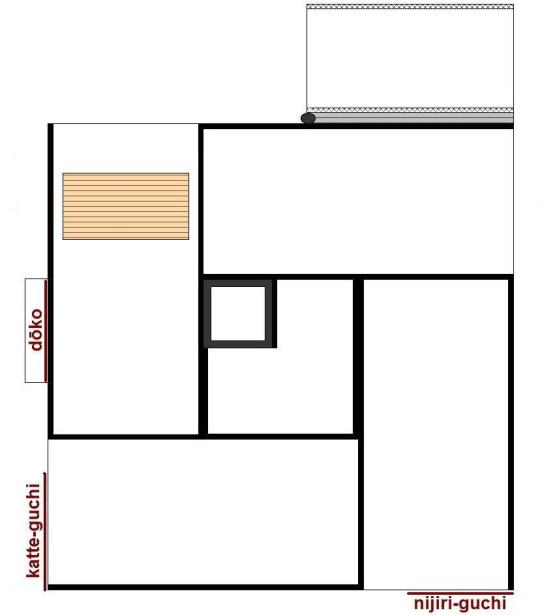
⁴Amano Hikosuke [天野彥右].
Though he is also mentioned as a guest in the Rikyū Hyakkai Ki [利休百會記], Amano Hikosuke has not been identified with any certainty.
⁵Ueda Hayato [上田準人].
This seems to refer to the bushō [武将] (military man) Tsuda Hayato [津田準人; ? ~ 1593]. It appears that Rikyū confused him, or at least his surname, with Ueda Satarō [上田左太郎].
Tsuda Hayato was a relative of Oda Nobunaga. Originally he served as a member of Nobunaga's cavalry (he held the position of sa-ma no suke [左馬允], third officer of the cavalry's left division), eventually rising to be the protector (or guardian) of Nobunaga's puppet-shōgun Ashikaga Yoshiaki [足利義昭; 1537 ~ 97]*. After Nobunaga's death, he served Hideyoshi in various capacities.
Tsuda Hayato was also actively involved with chanoyu.
__________
*Yoshiaki was the fifteenth and last shōgun of the Ashikaga family. He was essentially deposed by Nobunaga in 1573, by being driven out of Kyōto, though he never officially relinquished his title. Thereafter he shaved his head and took the Buddhist name Shōzan Dōkyū [昌山道休].
Some time after Nobunaga's death, Hideyoshi invited Yoshiaki to return to the throne -- on the condition that he adopt Hideyoshi as his heir (so Hideyoshi could become the sixteenth Ashikaga shōgun), but Yoshiaki refused.
⁶Sho [初].
The details of the sho-za [初座] begin here.
⁷Hino-dono yori kyō [no] gyoen no kiku to te, o-tanzaku musubite dasare sōrō wo, kago ni te toko kakeoki-sōrō sono mama [日野殿ヨリ今日御宴ノ菊トテ、御短尺ムスヒテ被下候ヲ、籠ニテ床ニカケ置候其儘].
Rikyū received a chrysanthemum (with a tanzaku* tied to it) as a gift from Lord Hino†. In order to display it so that the guests could also read the poem without difficulty, Rikyū decided to arrange the flower in a hanging basket hanaire.
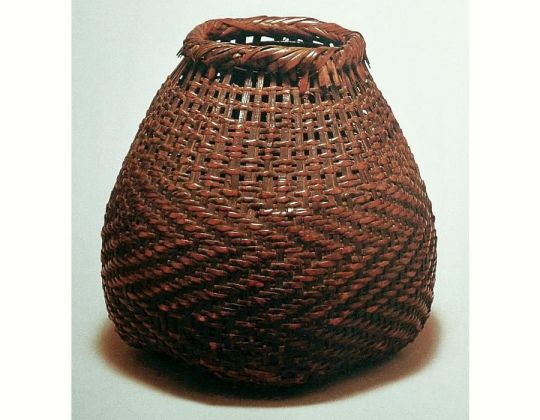
Rikyū's Katsura-kawa kago [桂川籠], which he used as a kake-hanaire, is shown above.
Kakeoki-sōrō sono mama [カケ置候其儘]: Rikyū just put the chrysanthemum in the hanging basket, without manipulating it in any way: he was not “arranging” the flower; he was simply displaying it as it was received from Lord Hino.
___________
*At court banquets, it was the custom for the high noblemen to compose congratulatory poems, which were written on tanzaku (a piece of paper 2-sun wide and 1-shaku 2-sun long, that had a hole in the center near the upper edge, by means of which they were tied to a seasonally auspicious floral offering -- in this case, a chrysanthemum -- and so presented to the Emperor; the flowers were arranged in front of his seat, and after the conclusion of the banquet the authors were apparently allowed to reclaim their flower and poem as a souvenir).
†Hino dono [日野殿] refers to Lord Hino Terusuke [日野輝資; 1555 ~ 1623], a kuge [公家] (a court noble -- a hereditary nobleman, rather than someone who had been elevated to the rank of courtier from the military caste), who was the Gon-dainagon [権大納言] or (supernumerary) Chief Counselor of State (senior grade of the Second Rank).
⁸Kama ・ unryū jizai [釜・雲龍 自在].
This was the second small unryū-gama [小雲龍釜] with matsu-kasa kantsuki [松笠鐶付] (shown below) and an iron lid, that Rikyū had ordered from Yoshirō after presenting the original kama (along with the large Temmyō kimen-buro) to Hideyoshi, for use in the Yamazato-maru tearoom in the boathouse of Ōsaka castle.
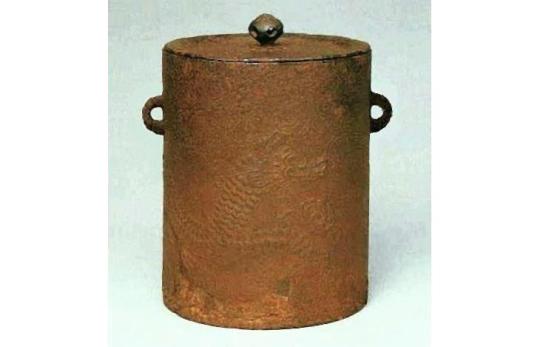
This small kama* was suspended over the ro on Rikyū’s abura-dake jizai [油竹自在]†, using his bronze kan [鐶] and tsuru [弦] (both of which are shown below).

___________
*Rikyū used the small unryū-gama because it would boil quickly. This was an impromptu chakai, and using this kama would allow Rikyū to prepare fresh water for the tea (rather than using water that had been boiling all day, or else changing the water in the large ro-gama and then waiting for it to come to a boil -- with nothing to distract the guests, since preparing a full kaiseki without prior notice would have been impossible).
†Abura-dake [油竹], which means “oily bamboo” (oil-stained bamboo) is usually called susu-dake [煤竹] (smoky-bamboo; smoke-stained bamboo) today. Both names refer to the 1-sun diameter bamboo poles taken from the underside of a farmhouse kitchen when the building was repaired or rebuilt, that have been stained by exposure to years of oil-filled cooking smoke. As a result, the bamboo becomes a dark brown-purple in color (though the color is mottled, rather than being uniform as in the case of artificially dyed bamboo).
⁹Fukuro-dana ni [袋棚ニ].
This refers to the fukuro-dana that was created by Jōō (shown below), based on the similar tana that was used by the Shino family at their incense and tea gatherings.
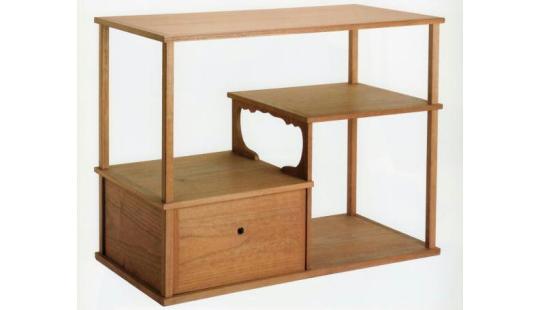
The Shino-dana [志野棚] has a pair of hinged doors, with a locking mechanism (to keep the host’s collection of kyara [伽羅] incense wood, that was stored in the ji-fukuro, safe); Jōō replaced the pair of locking doors with a single lift-out door -- and he also changed the procedures so that the guests were encouraged to open the ji-fukuro to inspect its contents each time they entered the tearoom (the shōkyaku was responsible for opening the door, while the last guest was charged with closing it again before the host entered for the temae).
Jōō’s famous Daikoku-an poem refers to this fukuro-dana.
◎ While Jōō originally taught that the fukuro-dana should be placed on the right side of the mat (so that its right edge sat on top of the right heri of the utensil-mat), after Rikyū entered Hideyoshi’s service (if not before) he began to center the fukuro-dana on the utensil mat (just as is done with all of the other oki-dana [置棚] during the ro season).

◎ At the beginning of the sho-za, the habōki and kōgō were arranged together on the naka-dana (the shelf above the mizusashi), with the mizusashi below.
¹⁰Kōgō・ Chōjirō kaki [香合・長二郎 カキ].
There appears to be an error in this entry. All of the manuscripts of the Nampō Roku (apparently including Jitsuzan’s original version which he copied with the original Shū-un-an documents in front of himself) -- with the exception of the presentation copy that Tachibana Jitsuzan gave to the Enkaku-ji -- read kōgō ・ Chōjirō-yaki [香合・長二郎ヤキ]*. Only the Enkaku-ji version reads kōgō ・ Chōjirō kaki [香合・長二郎 カキ].
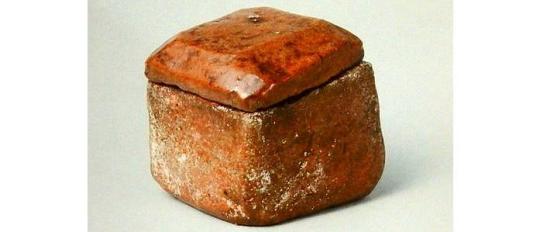
The issue can best be addressed in this way. Chōjirō [長次郎] (to use the currently accepted representation of his name) had been employed by Hideyoshi to create the (unglazed) sculptures that would decorate the roofs of his Juraku-tei [聚樂第] palace (which entered the initial stages of construction earlier the same year -- 1586). Making glazed pottery for Rikyū was a side-job, almost more like a hobby. Chōjirō appears to have been familiar with the basic technology (which was similar to pottery techniques used in the kilns at Masan, in Korea -- though in that case they coated the raw clay with white slip before glazing, while Chojiro was using a slip colored with red iron-oxide), though it seems that he had never used it before in his own craft. Since he was not a professional potter who worked with glazes, he was still in the experimental stage in the autumn and winter of 1586, thus his bowls and other pieces from this early period are generally very simple and regular in shape (since he was still learning how the clay body interacts with glaze, and how both respond to the heat in the kiln). Chōjirō, as a professional sculptor, would certainly have been capable of modeling a kōgō that resembled a persimmon (or, indeed, an even more elaborate shape); but the other pieces fired at this time suggest that he did not do so because he was still learning how to make glazed pottery.
The error likely crept in because the katakana for ka [カ] is similar to the katakana for ya [ヤ] -- and the similarity may be even more pronounced in handwritten documents (and especially if the writing was done quickly, as appears to have been the case when Jitsuzan copied the Shū-un-an documents -- since he was apparently given only limited access to them). When Jitsuzan got around to writing out the presentation copy, he may have forgotten what he had originally seen, and interpreted his notes through contemporary knowledge -- that the pottery was referred to as Raku-yaki (not Chōjirō-yaki), even when speaking about pieces made by Chōjirō; and because the Raku family was, in his day, making kōgō in all sorts of shapes, including persimmons, copied from the so-called “katamono kōgō” [型物香合] that had been imported from the continent†.
The cube-shaped kōgō shown above was made by Chōjirō during the early part of his career as a Raku potter‡. Indeed, this seems to be the earliest kōgō-like piece associated with his name. Thus, it may either be the kōgō that Rikyū used on this occasion**, or a sibling fired around the same time.
___________
*Some second-generation manuscripts, which were copied from the earlier versions, unambiguously read Chōjirō-yaki [長二郎燒] -- meaning that this word is being used as the name for the early Raku-ware created for Rikyū by Chōjirō [長次郎].
†As an example, here is a modern Korean copy of a classical Korean container (used as a seal-ink case), and a modern Raku kaki-kōgō.

The latter was clearly inspired by the prototype of the former, even if it was not copied directly.
‡Both the unstable quality of the glaze, and the fact that the piece had partly collapsed from the heat of firing attest to its early date.
**The imperfect quality of this piece (which mirrors the same sort of imperfection in both glaze and shape seen in Chōjirō’s mizusashi that was used during the first two chakai described in this kaiki from 1586~7) seems to be just the sort of thing that Rikyū appreciated; and its use on the (finely crafted) fukuro-dana would have been characteristic of his tastes as well.
¹¹Habōki [羽箒].
Rikyū does not mention the kind of feathers used for this habōki -- probably because habōki were replaced frequently*, and so did not demand special notice.
Because Rikyū is using an o-dana [大棚] in a 4.5-mat room, the habōki is of the larger size (with feathers around 9-sun long) -- the kind most commonly seen today†.

Because the chakai was taking place at night, it seems logical that he would have used some sort of light-colored feathers, such as those from a swan (haku-chō [白鳥]), shown above.
Rikyū seems to have gotten his feathers from the birds taken by Hideyoshi’s hawkers, and a quick glance back at the Rikyū Hyakkai Ki will give the reader an idea of the possibilities.
___________
*Some people during his period actually used them only once -- which is why we have very few authentic examples of habōki from Rikyū’s day.
†Because they were changed frequently, few habōki survived from Rikyū’s day (or before) into the Edo period. And, curiously, those that did were all habōki made from especially beautiful feathers from the earlier period (when a 4.5-mat room was always used -- in a room of 4.5-mats and larger, the “utensil mat” is considered to be a maru-jō, a full-sized mat; thus a larger habōki was used to clean it).
Lacking (or perhaps closing their eyes to) other examples, the machi-shū schools argued that the surviving habōki with feathers that average 9-sun in length were the only kind that were acceptable for use -- even in the small room, and even on the daime (and so directly opposed to Rikyū’s own teachings on the matter).
This is why the go-sun-hane [五寸羽] that were preferred by Rikyū for use in the small room (where the utensil mat is always considered to be a daime -- whether it is actually a daime-tatami or a full-length mat) are rarely seen and almost unknown today.
¹²Mizusashi ・ Shigaraki [水サシ・シカラキ].
This was Rikyū’s Shigaraki mizusashi, the same one he used during the chakai recorded in the Rikyū Hyakkai Ki.

In the sixteenth century (as had always been the case), the potters were primarily making things for home and commercial use, not for chanoyu. For the most part, they made tea utensils only on commission -- though it was from around this time (the last quarter of the sixteenth century) that some potters did occasionally make things that could be used for chanoyu without their being pre-ordered, and fired them when there was space in the kiln.
While some pieces were fired only once (like this one), others -- such as the hanaire and mizusashi that were heavily encrusted with natural ash deposits that were favored by Oribe -- usually went through multiple firings (it seems these pieces were simply left in the kiln when the utilitarian objects were removed for sale, in accordance with the feedback that the potters had received from people like Rikyū and Sōshitsu).
Because of the still relative rarity of such things, when a chajin acquired a piece that fulfilled his needs (aesthetic as well as practical), he was unlikely to think about replacing it.
¹³Na-kago [菜籠].
The original na-kago [菜籠]* were shallower than this sumi-tori, made with a square bottom and somewhat flaring, circular mouth, and intended to display produce in the wet market (generally the price quoted by the merchant was for the contents of one basket).
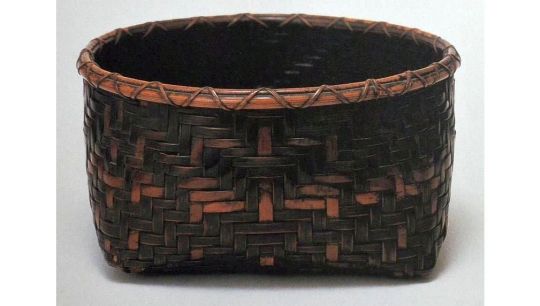
This kago was made for Rikyū, probably to his design, and intended to be used as a sumi-tori†. The kind of bamboo that was used was referred to as abura-dake [油竹] (oily bamboo) in Rikyū’s period‡, and was salvaged from the underside of the roofs of farmhouses when they were rebuilt. Rikyū liked this kind of bamboo because of its mellow, aged appearance. Because the bamboo that was used to line the roofs was usually just 1-sun in diameter (this kind of bamboo was commonly available everywhere in Japan), with thin walls, it was suitable only for use when making something like a jizai [自在], for the so-called “purple” chasen and chashaku, or split and used in basketry, as here.
___________
*The kanji can also be pronounced sai-ro [菜籠].
†While Jōō‘s rule was that basket sumi-tori were to be used with the furo, and fukube sumi-tori were to be used with the ro, Rikyū occasionally used a basket with the ro. Aside from aesthetics, Rikyū’s usage may simply reflect the fact that tea utensils were increasingly being made specifically for use in chanoyu (and thus something like a basket could be made whatever size the person ordering it preferred), whereas in Jōō’s day people used pre-existing things that they found in the market (and na-kago, as the usual way to display produce, were both ubiquitous, and of a uniform size -- and that size was too small to hold a whole day’s supply of charcoal the way a fukube could), and so their preferences were limited to what they could find. In fact, this was how it had been since the beginning of chanoyu. Making things specifically for chanoyu was really a revolutionary idea, one that began with Furuta Sōshitsu -- and it was one of Oribe’s greatest contributions to the way that chanoyu evolved thereafter.
‡It is usually called susu-dake [煤竹] (smoke-stained bamboo) today, probably because the word abura-dake (especially when thinking about chasen) makes people think that it will damage the taste of the tea.
¹⁴Hoshi-sakana aburite [干肴 アフリテ].
Hoshi-sakana [干し肴] means “dried fish;” aburu [炙る] means to roast or char over a charcoal fire. Hoshi-sakana aburite is shown below.
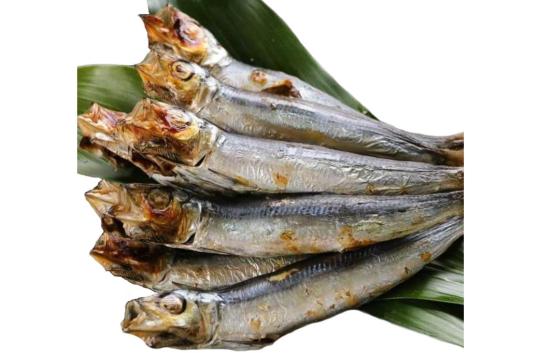
The most common fish served in this way is the ma-iwashi [真鰯] (Sardinops melanostictus), known as the Japanese pilchard (a kind of “sardine”). It is also known in Japanese as nanatsu-boshi [七つ星] (”seven stars”), which name was explained as being a reference to the fact that usually seven of the dried fish (which are silver-gray in color) are tied together with a rice straw cord, and so sold in the market (the above photo, perhaps coincidentally, shows seven fish). Usually fish between 5- and 6-sun in length that were air-dried are served in this way.
This kind of food is a typical side-dish served together with sake [酒] -- even today.
¹⁵Sake ni kaeshi [酒 二返].
Kaesu [返す] means to come back, return. In the traditional drinking custom, the host drinks with each guest (he pours for the guest, and then the guest returns the sakazuki [盃] to the host, and pours him a drink of sake).
¹⁶Mizu-kuri [水栗].
The “water chestnut” (the English name is a translation of one of its Chinese kanji names) is the corm of the sedge known as shiro-guwai [白慈姑] (Eleocharis dulcis) in Japan. While often sweetened today by boiling the corms for a short time in honeyed water, they can also be grilled over charcoal, or even eaten raw. It is not clear from the kaiki how Rikyū prepared the mizu-kuri on this occasion.
However, both Tanaka Senshō and Shibayama Fugen quote a different explanation: according to their source, raw chestnuts are shelled, and then the pellicle (the thin, brown “skin” that covers the creamy-white flesh) is scraped away from one half of each fruit in a comma-like shape (”,”), so that each fruit resembled a 3-dimensonal futatsu-tomoe [二つ巴] (the “Yin-Yang” symbol). Because the pellicle is extremely bitter, the fruit must then be soaked in water for several hours to leech out the bitterness, after which the mizu-kuri can be served.
While their information is surely historically accurate, so far as this way of preparing raw chestnuts is concerned, the problem with their idea is that this was a fu-ji [不時] -- impromptu -- chakai. If Rikyū had sufficient forewarning to prepare a snack that required several hours of soaking, he would have had adequate time to cook and serve a kaiseki.
¹⁷Go [後].
This refers to the go-za [後座], the description of the arrangements for which follows.
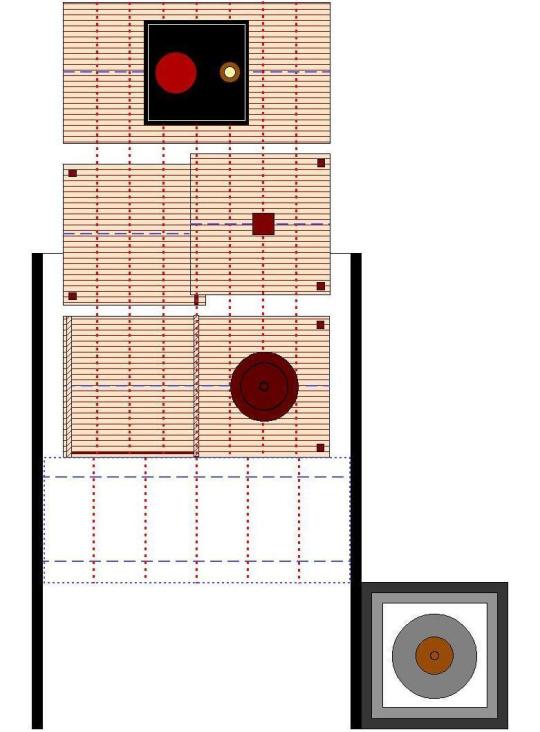
◎ At the beginning of the go-za, the, the chaire and chawan were arranged together on a naka-bon [中盆], displayed on the tei-ita of the fukuro-dana, and the meibutsu futaoki was displayed alone on the naka-dana (the shelf above the mizusashi). The mizusashi remained as it was during the sho-za.
¹⁸Chaire ・ nasubi [茶入・ナスヒ].
This seems to be the nasu chaire now known as the Rikyū ko-nasu [利休小茄子] -- because the other “nasu-chaire” associated with Rikyū -- the Konoha-zaru [木ノ葉猿] -- would be too large to be arranged on a naka-bon together with Rikyū’s temmoku. The Rikyū ko-nasu is between 1-sun 9-bu and 2-sun in diameter; the Konoha-zaru chaire is 2-sun 5-bu in diameter.
Rikyū is said to have presented this chaire to Hideyoshi sometime after the present chakai.
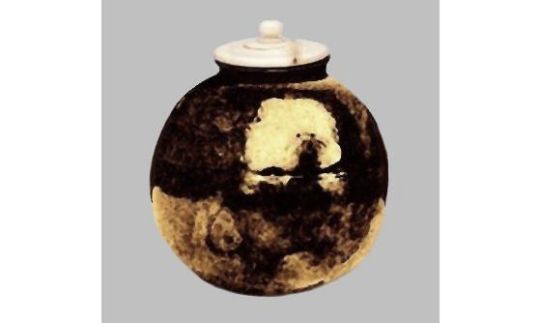
This chaire is rarely seen today -- indeed, the above photo from the beginning of the 20th century, is the only one I could find. This chaire is considered to be a kan-saku karamono [カン作唐物 = 韓作唐物], which means it was made in Korea during the first half of the fifteenth century.
The small size means that it can only hold enough tea for two guests* (if both koicha and usucha will be served).
___________
*This is, in fact, usual with respect to the ko-tsubo chaire. In the old days, ko-tsubo were used when serving tea to a nobleman (originally, to the image of the Buddha). Thus only a single bowl of koicha would be made during the temae (the fact that the chaire held more than enough tea was a precaution; and filling the chaire fully also helped to protect the tea from contact with the air, which would cause it to degrade).
¹⁹Temmoku [天目].
This was Rikyu’s temmoku chawan, which he sometimes referred to as an ake-temmoku [朱天目], which is a sub-variety of the nogime-temmoku [禾目天目] that has an especially reddish-toned glaze. It appears that this chawan was actually produced at the Seto kilns; though what Rikyū knew or believed about its origins is unclear from the records that he left*.

This chawan measures 4-sun in diameter.
On this occasion, the (empty) temmoku was displayed on the naka-bon without its shifuku†. The temmoku-dai (if one was used‡) would have been put inside the ji-fukuro prior to the temae.
___________
*Rikyū clearly seems to have handled it as if it were a karamono temmoku.
†Rikyū actually seems to have disliked this classical practice, considering that the cloth of the shifuku would trap dust, which could fall into the chawan as lint, and make it dirty. He preferred to rinse the chawan in the mizuya, and then leave it without a covering -- whether or not the chakin, chasen, and chashaku were placed in it (though the absence of the shifuku is an invitation for the host to do this, too).
‡Nothing is said in the kaiki regarding this point. The temmoku-chawan could not have been displayed on the naka-bon together with the chaire if it were resting on its dai: the naka-bon is too small for this kind of arrangement.
Rikyū generally seems to have felt that a dai should be used only when serving a nobleman (what the modern schools usually call kijin-date [貴人立て, or 貴人點] today). And while it could be argued that Hosokawa Yūsai might be so treated, because this gathering was taking place at night (when it is generally more difficult to do things), the setting itself would argue against its use.
²⁰Naka-bon [中盆].
While both Shibayama Fugen and Tanaka Senshō say this refers to the round naka-maru-bon [中丸盆] that was one of the six meibutsu trays that were used with the daisu, the larger size of that tray would have made it more difficult to manage at night, when the room was dark. Consequently, the square naka-bon seems more likely.
The shi-hō naka-bon [四方中盆] was not one of the original six meibutsu trays that were used with the daisu. Nevertheless, its use dates at least from the fifteenth century. It is also described in Book Six (“Sumi-biki” [墨引き]) of the Nampō Roku (along with the other six trays).

This shi-hō naka-bon measures 1-shaku square.
___________
*Rikyū’s personal preference for smaller trays also argues for the 1-shaku square shi-hō naka-bon. Also, Rikyū preferred square trays to round ones -- since square trays can be oriented with greater accuracy.
The naka-maru-bon measures 1-shaku 2-sun 3-bu in diameter -- slightly larger than the space available in front of the fukuro-dana. Something else that would have chafed on Rikyū’s sense of propriety.
²¹Futaoki ・ in [蓋置・印].
This was the meibutsu Rinzai-in [臨濟印] (a square bronze name-seal, purportedly made by order of the Emperor of China, that was used by the Tang period Chán monk Línjì Yìxuán [臨濟義玄; ? ~ 866]).
This name-seal had formerly belonged to the great dōbō [同朋] Nōami [能阿彌; 1397 ~ 1471]; and its use as a futaoki is generally credited to him.
Rikyū follows Nōami’s precedent at this chakai.
The Rinzai-in would have been displayed in the middle of the naka-dana (the shelf above the mizusashi) of the fukuro-dana, with the hishaku placed on the kō-dana (the shelf that forms the roof of the ji-fukuro).
²²Kae-chawan ・ e [カヘ茶碗・繪].
This chawan dates to the middle of the Ming dynasty, and was probably imported from the continent around the middle of the sixteenth century.
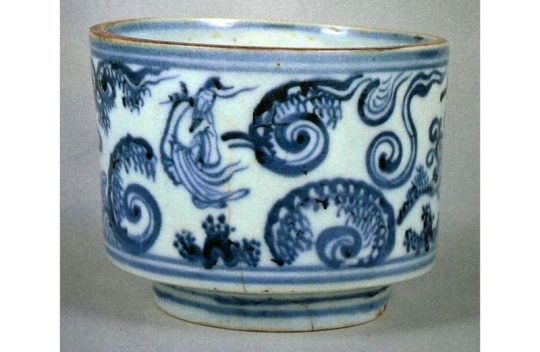
The bowl seems to have been made as an ordinary rice bowl, rather than for any special purpose.
This chawan is now known by the name of Ki-mi-i-dera [紀三井寺], which is a (perhaps fanciful) reference to the painting that decorates the face of the bowl; it is also said to have been one of the first sometsuke [染付] bowls to be used as a chawan in Japan.
The chakin, chasen, and chashaku were brought into the room arranged in the kae-chawan. It may also have been used to help facilitate the serving of usucha afterward.
²³Chashaku ・ ori-tame [茶杓・折タメ].
This would have been a chashaku that Rikyū made to be used with the ko-nasu chaire [小茄子] that is shown above -- albeit in consideration of the fact that it would be rested on a naka-bon (which means that the chashaku had to be longer than if the chaire were being used with a smaller chaire-bon).

²⁴Koboshi ・ Bizen [コホシ・備前].
The Bizen-yaki koboshi shown below was apparently recovered from the site of Rikyū’s former residence (in the Ima-ichi area of Sakai, near the entrance to the Nanshū-ji). The irregular coloring is due to the fact that it was recovered in fragments, and the missing pieces were replaced without attempting to obscure the fact.

This piece may be the actual Bizen koboshi that Rikyū used during this chakai.
1 note
·
View note
Photo

【若潮酒造の美味しい焼酎が飲めるお店】 【 海鮮割烹居酒屋やまだや 様 チキン南蛮定食 】 ( チキン南蛮 、あら汁、照り焼きチキン、白若潮(シロワカシオ)、 ランチ ) ( 鹿児島県 志布志市 志布志町 志布志 ) 若潮酒造株式会社の焼酎が飲めるお店をご紹介致します。 今回ご紹介するお店は、 やまだや 様です。 今回は、チキン南蛮定食 にしました♪ チキン南蛮 、あら汁、照り焼きチキン、白若潮(シロワカシオ)⤴⤴⤴😋 チキン南蛮、お肉がジューシー♪ 癖になるお味\(//∇//)\ 照り焼きチキンも美味しい⤴⤴⤴😋 お魚の出しのきいたお味噌汁も最高です(σ≧▽≦)σ 幸せを感じるひとときでした♪ 海鮮割烹 居酒屋 やまだや 様では‼ プレミア焼酎 志布志シリーズ も飲むことが出来ます♪ ( 志布志 、 志布志プレミアムブルー 、 志布志プレミアムピンク ) ※志布志プレミアムピンクは、年一回500本限定の焼酎です。 皆さん是非 海鮮割烹居酒屋 やまだや 様で美味しいお料理と美味しい焼酎を堪能して下さいね~~~\(^^)/ やまだや海鮮割烹 様情報 ( ヤマダヤカイセンカッポウ ) 店長 = 小迫様 住所 = 鹿児島県志布志市志布志町志布志2-2431-2 電話番号 = 099-473-2788 営業時間 = 11:00~14:00 17:00~22:00 ランチ営業 、 日曜営業 定休日 = 年末 ・ 年始 ※焼酎 志布志 情報 ( しょうちゅう しぶし ) 焼酎志布志は、 若者達が 焼酎 を飲んでヤバイ!! 地元の方達も わっぜうまか焼酎 やね!! 沢山の皆さんに、おほめの言葉を頂いた最高の 焼酎志布志 ♪ 凄く美味しい焼酎なので、皆さん是非ご賞味下さい\(^-^)/ ____________________________ ✨若潮酒造受賞歴✨ 鹿児島県本格焼酎鑑評会 ✨22連続受賞‼✨ ____________________________ ※若潮酒造の焼酎は、プリン体0・糖質0・甘味料0 、体に優しい芋焼酎です(^^♪ ※焼酎は、色々な飲み方が出来て楽しいです♪ 冷やしてストレート、グラスにいっぱいに氷を入れてロック、氷と炭酸水を入れてソーダ割り(焼酎ハイボール)、グラスにお湯を入れてお湯割り、柑橘系&炭酸水を入れて、カクテル、酎ハイ、色々な飲み方が出来ます♪ 皆さん是非、自分好みにアレンジして楽しんでくださいね~♪ ※若潮酒造の焼酎が日本全土 、 全都道府県 に広がるように頑張ります。 ( 北海道 青森県 岩手県 宮城県 秋田県 山形県 福島県 新潟県 茨城県 群馬県 栃木県 埼玉県 東京都 千葉県 神奈川県 山梨県 長野県 富山県 石川県 福井県 静岡県 愛知県 岐阜県 三重県 大阪府 京都府 滋賀県 兵庫県 奈良県 和歌山県 鳥取県 島根県 岡山県 広島県 山口県 徳島県 香川県 愛媛県 高知県 福岡県 佐賀県 長崎県 熊本県 大分県 宮崎県 鹿児島県 沖縄県 ) ★若潮酒造は見学、ツアーも出来ますので皆さん是非若潮酒造に遊びに来て下さいね♪ ( 会社が休みの場合も有りますので、見学に来られる際は事前に御連絡して下さいね。) 若潮酒造株式会社への 商品、見学、ツアー お問い合わせ 若潮酒造電話番号 = 099-472-1185 若潮酒造住所 = 鹿児島県志布志市志布志町安楽215 お気軽にお電話下さい (^^♪ ✨若潮酒造公式ホームページ✨ http://wakashio.com/ ※皆さん是非ホームページにアクセスして下さいね(๑•̀ㅁ•́ฅ✧ ★☆★☆★☆★☆★☆★☆★☆★☆★☆★☆★☆★☆★☆★☆ #海鮮割烹居酒屋やまだや #海鮮割烹居酒屋 #海鮮割烹 #海鮮 #割烹 #居酒屋 #やまだや #若潮酒造株式会社 #若潮酒造 #若潮酒造服部明 #焼酎 #國酒 #茶酎 #本格焼酎 #芋焼酎 #麦焼酎 #黄若潮 #焼酎志布志 #志布志プレミアムブルー #志布志プレミアムピンク #チキン南蛮定食 #鹿児島県 #志布志市 #あら汁 #志布志 #しぶし #ディナー #其ノ儘 #ランチ #しょうちゅう ★☆★☆★☆★☆★☆★☆★☆★☆★☆★☆★☆★☆★☆★☆ 若潮酒造服部明。 私の個人サイトなので、お気軽にフォローして下さいね。 Instagram インスタグラム = https://www.instagram.com/wakashio_hattori/ Twitter ツイッタ― = https://twitter.com/wakashio11 youtube ユーチューブ = https://www.youtube.com/channel/UC9iyw41rfoD-_jOSQiDQx1g アメーバブログ = https://profile.ameba.jp/ameba/wakasiho Facebook フェイスブック = https://www.facebook.com/wakashio11 ラインID = wakashiohattori 携帯電話番号 = 09028547052 良かったら チャンネル登録 お願い致します♪ http: (海鮮割烹居酒屋やまだや) https://www.instagram.com/p/CCLrzPcgwT9/?igshid=120espmfw1niz
#海鮮割烹居酒屋やまだや#海鮮割烹居酒屋#海鮮割烹#海鮮#割烹#居酒屋#やまだや#若潮酒造株式会社#若潮酒造#若潮酒造服部明#焼酎#國酒#茶酎#本格焼酎#芋焼酎#麦焼酎#黄若潮#焼酎志布志#志布志プレミアムブルー#志布志プレミアムピンク#チキン南蛮定食#鹿児島県#志布志市#あら汁#志布志#しぶし#ディナー#其ノ儘#ランチ#しょうちゅう
0 notes
Photo










気違宗中本山
不動山前進寺
縁起絵巻
当山は山号を不動山と称し、寺号を前進寺と、称します
名は体を現す、と申しますが、
「不動なるが故に前進す、前進するが故に不動なり」と云う
御教えを体現しております、有り難い山号寺号であります
古来より流されやすい世相に、竿を指してまいりましたら、
いつしか、世の中の方が変わり過ぎ、動かざること山の如きに変わらなかったのが、ワルカッタのか、ソウなのか、だが、しかし、其の故に前進していると言いましょうか、はたまた、世の中が変わってしまって、変わらないのは当山だけなので、不動だ、と言いましょうか、いや、まったく、世の中の三千億万劫、遅れている、と言いましょうか、はたまた、六千憶万兆由旬後方に居てると言いましょうか、遅れついでに、古来より、きちがい寺と親しまれ、参詣の善男善女悪男悪女が絶えることなく、参詣されておりますところで御座います。
また、
「我もまた、狂者と為りて、この国を破滅させん、この社会に仇を為さん」
「少なくとも精神医と看護婦看護士と心理職には落とし前を付けなん」と
狂之修行者の入山も後を絶ちません
一般には、山科のきちがい寺、きーさん寺、日ノ岡のだんだらさん、と親しまれております
口に
南無キーサン革命如来南無赤黄だんだら不動明王尊を唱え、
我が身の背足乃至裏足をもちて、
精神医療従事者の中段横三枚に廻蹴を加撃し、
心にキーサン革命バンザいクタバれ精神医、カチコンだろか、と意するは、
此れ即ち身口意三密の行、即身成鬼極楽往生の因たるべし
愚怒禿説
魔訶般若キーサン革命観世音菩薩気違経
狂鬼怨念普門品第百七
精神医加電撃患者頭蓋部
念彼観音力
電撃器段々壊
看護婦強制患者入保護室
看護士強制連行閉鎖病棟
念彼観音力
鉄格子段々壊
即得解脱
精神医勝手気儘増薬或勝手気儘減薬
念彼観音力
精神医段々壊
心理士強制患者心理試験
念彼観音力
心理士心理段々壊
看護婦強制四肢拘束
看護士強制五点張
念彼観音力
拘束帯段々壊
即得解脱
心理士強制国家試験変成公認心理師
念彼観音力
心理士加公認心理師諸共段々壊
精神医勝手気儘診断書或勝手気儘処方箋
念彼観音力
精神医段々壊
精神医勝手気儘診断発達障害無理矢理断薬
念彼観音力
発達障害段々壊
発達障害段々崩壊益々破壊強烈破滅
唱え奉る魔訶般若キーサン革命観世音菩薩気違経の功徳は
精神医療一切皆苦
精神福祉一切皆空
とぞ照見する所也
その故に後生の一大事をかけて
速やかに一念発起してカチコミを掛け奉り
即日即知
進者無間地獄
退者亦復無限地獄
六方四周一切悉尽無間地獄
とぞ、申したれ
然れば即ち
南無帰命刃十方無毛光キーサン革命如来と
念じ給いて世の中に仇を為さんとす行者
是れ即ち狂之行者狂変大菩薩とは、申すべきもの也
菩薩行の最たるも最
極楽往生即身成鬼決定入正定之聚とも釈せし者也
能々可在吟味事
あなかしこあなかしこ
二〇一五年五月起稿 キーサン革命の鬼 えばっちより
ありがたやありがたや、ありがたきことでございます
友の会みんなの部屋の、亡くなったなかまたちの御遺影前祭壇にて
時たまに心中にて読経しておりますモノデスが
せっかくですので、みなさまへも、御披露させて頂きました
精神病患者会前進友の会やすらぎの里作業所
あくまでキーサン革命の鬼えばっち 江端一起
えばっちのはてなブログ
https://ebacciblog.hatenablog.com/
えばっちのホームページ 乾坤一擲
http://ebacchihomepage.dousetsu.com/index.html
えばっちのタンブラー
https://kisanebacci.tumblr.com/
前進友の会やすらぎの里のホームページ
http://yuinoumi.web.fc2.com/zenshin-index.html
0 notes
Text
気違宗中本山 不動山前進寺 縁起絵巻「我もまた、狂者と為りて、この国を破滅させん、この社会に仇を為さん」 「少なくとも精神医と看護婦看護士と心理職には落とし前を付けなん」と 狂之修行者の入山も後を絶ちません

気違宗中本山 不動山前進寺 縁起絵巻
当山は山号を不動山と称し、寺号を前進寺と、称します
名は体を現す、と申しますが、
「不動なるが故に前進す、前進するが故に不動なり」と云う
御教えを体現しております、有り難い山号寺号であります
古来より流されやすい世相に、竿を指してまいりましたら、
いつしか、世の中の方が変わり過ぎ、動かざること山の如きに変わらなかったのが、ワルカッタのか、ソウなのか、だが、しかし、其の故に前進していると言いましょうか、はたまた、世の中が変わってしまって、変わらないのは当山だけなので、不動だ、と言いましょうか、いや、まったく、世の中の三千億万劫、遅れている、と言いましょうか、はたまた、六千憶万兆由旬後方に居てると言いましょうか、遅れついでに、古来より、きちがい寺と親しまれ、参詣の善男善女悪男悪女が絶えることなく、参詣されておりますところで御座います。
また、
「我もまた、狂者と為りて、この国を破滅させん、この社会に仇を為さん」
「少なくとも精神医と看護婦看護士と心理職には落とし前を付けなん」と
狂之修行者の入山も後を絶ちません
一般には、山科のきちがい寺、きーさん寺、日ノ岡のだんだらさん、と親しまれております
口に
南無キーサン革命如来南無赤黄だんだら不動明王尊を唱え、
我が身の背足乃至裏足をもちて、
精神医療従事者の中段横三枚に廻蹴を加撃し、
心にキーサン革命バンザいクタバれ精神医、カチコンだろか、と意するは、
此れ即ち身口意三密の行、即身成鬼極楽往生の因たるべし
愚怒禿説
魔訶般若キーサン革命観世音菩薩気違経
狂鬼怨念普門品第百七
精神医加電撃患者頭蓋部
念彼観音力
電撃器段々壊
看護婦強制患者入保護室
看護士強制連行閉鎖病棟
念彼観音力
鉄格子段々壊
即得解脱
精神医勝手気儘増薬或勝手気儘減薬
念彼観音力
精神医段々壊
心理士強制患者心理試験
念彼観音力
心理士心理段々壊
看護婦強制四肢拘束
看護士強制五点張
念彼観音力
拘束帯段々壊
即得解脱
心理士強制国家試験変成公認心理師
念彼観音力
心理士加公認心理師諸共段々壊
精神医勝手気儘診断書或勝手気儘処方箋
念彼観音力
精神医段々壊
精神医勝手気儘診断発達障害無理矢理断薬
念彼観音力
発達障害段々壊
発達障害段々崩壊益々破壊強烈破滅
唱え奉る魔訶般若キーサン革命観世音菩薩気違経の功徳は
精神医療一切皆苦
精神福祉一切皆空
とぞ照見する所也
その故に後生の一大事をかけて
速やかに一念発起してカチコミを掛け奉り
即日即知
進者無間地獄
退者亦復無限地獄
六方四周一切悉尽無間地獄
とぞ、申したれ
然れば即ち
南無帰命刃十方無毛光キーサン革命如来と
念じ給いて世の中に仇を為さんとす行者
是れ即ち狂之行者狂変大菩薩とは、申すべきもの也
菩薩行の最たるも最
極楽往生即身成鬼決定入正定之聚とも釈せし者也
能々可在吟味事
あなかしこあなかしこ
二〇一五年五月起稿 キーサン革命の鬼 えばっちより
ありがたやありがたや、ありがたきことでございます
友の会みんなの部屋の、亡くなったなかまたちの御遺影前祭壇にて
時たまに心中にて読経しておりますモノデスが
せっかくですので、みなさまへも、御披露させて頂きました
精神病患者会前進友の会やすらぎの里作業所
あくまでキーサン革命の鬼えばっち 江端一起
えばっちのはてなブログ
https://ebacciblog.hatenablog.com/
えばっちのホームページ 乾坤一擲
http://ebacchihomepage.dousetsu.com/index.html
えばっちのタンブラー
https://kisanebacci.tumblr.com/
前進友の会やすらぎの里のホームページ
http://yuinoumi.web.fc2.com/zenshin-index.html
0 notes